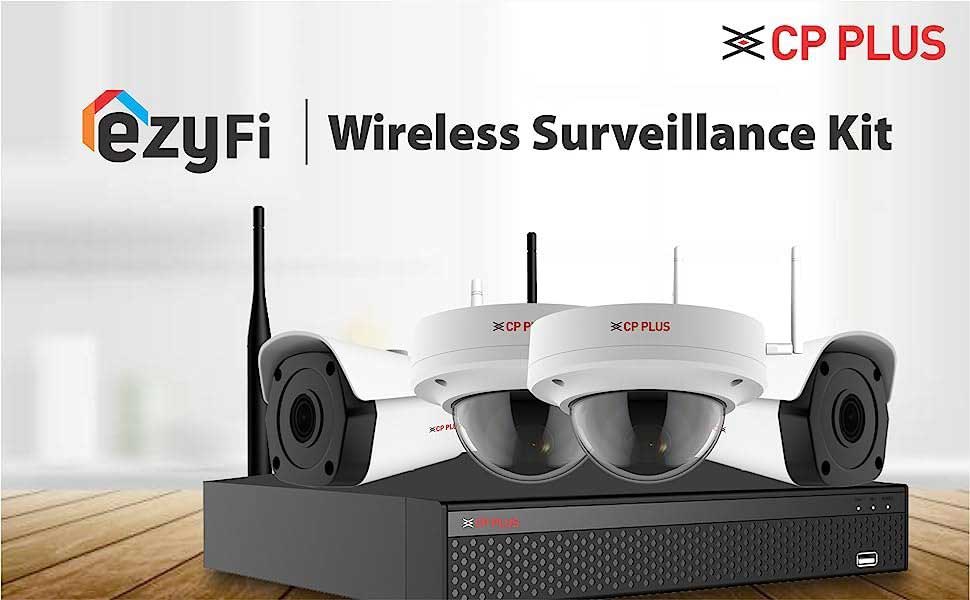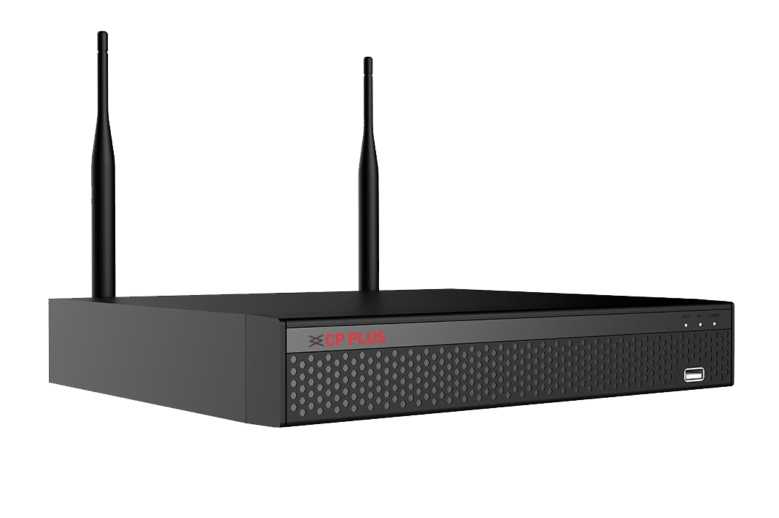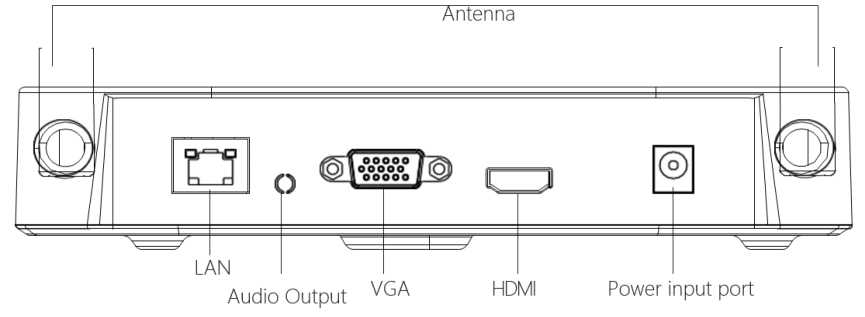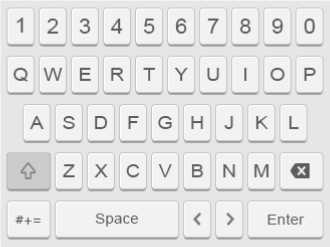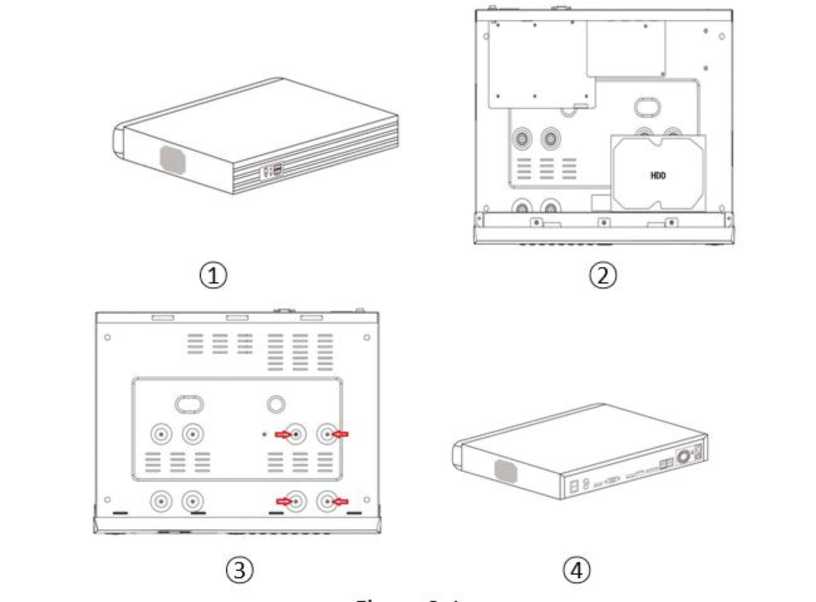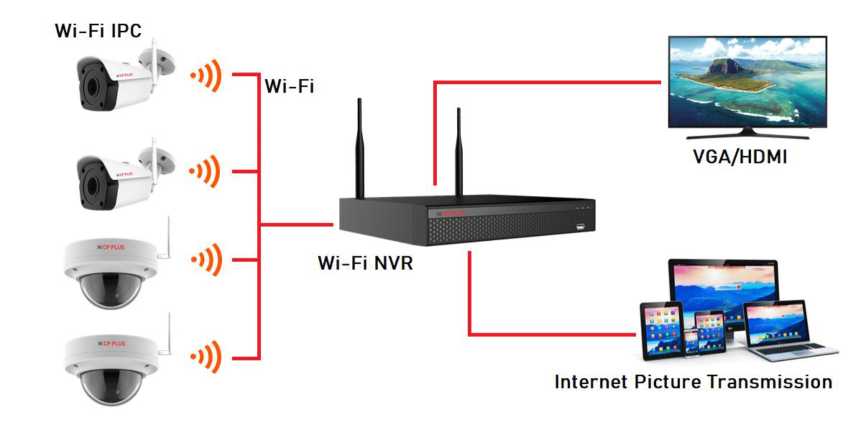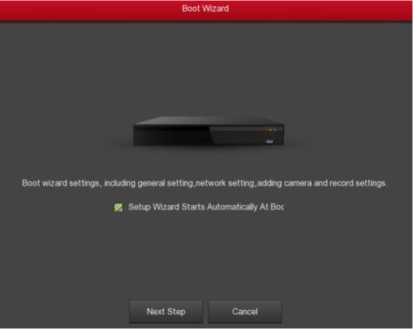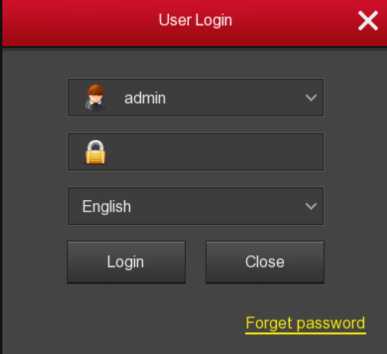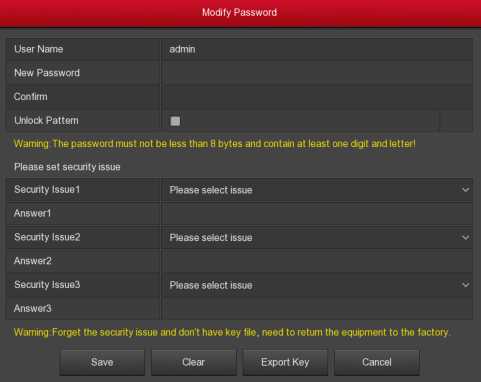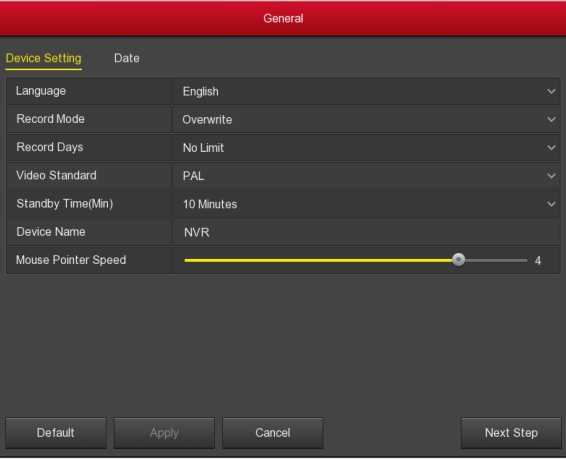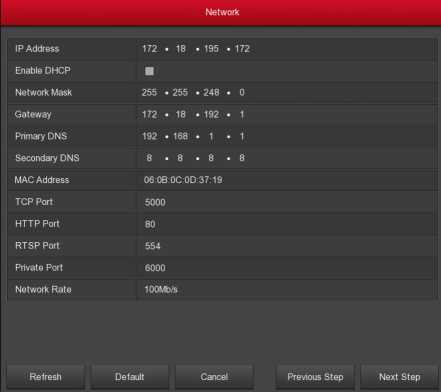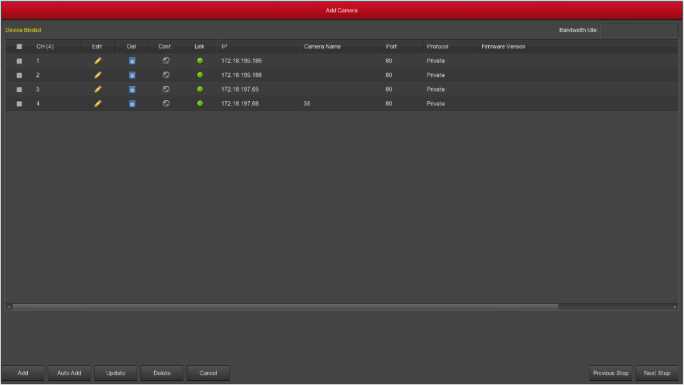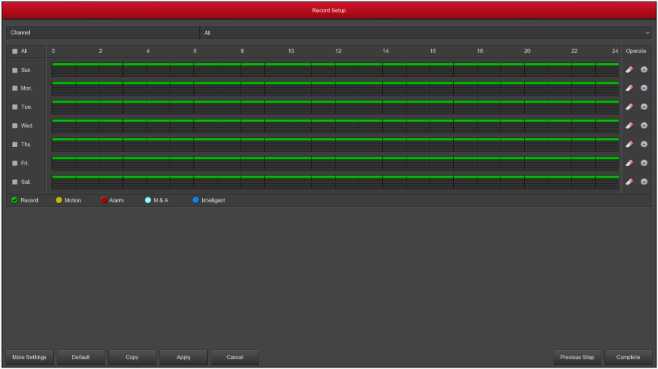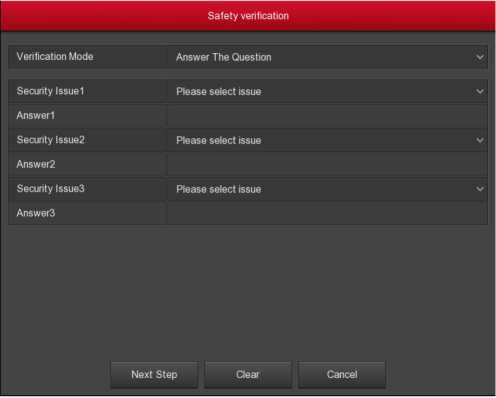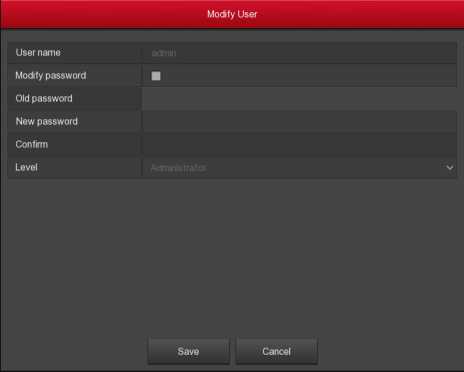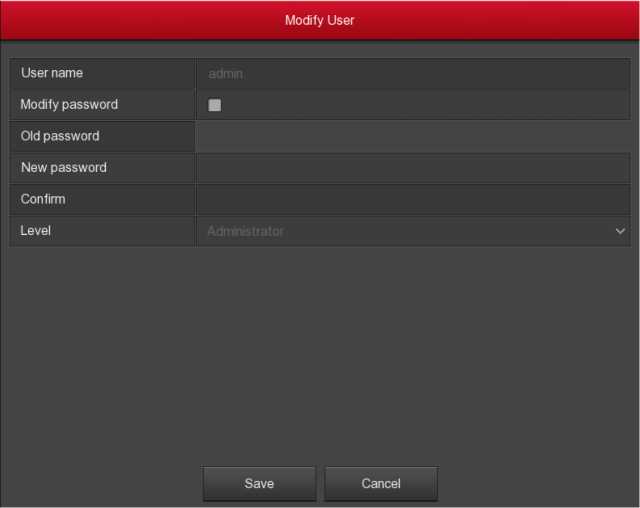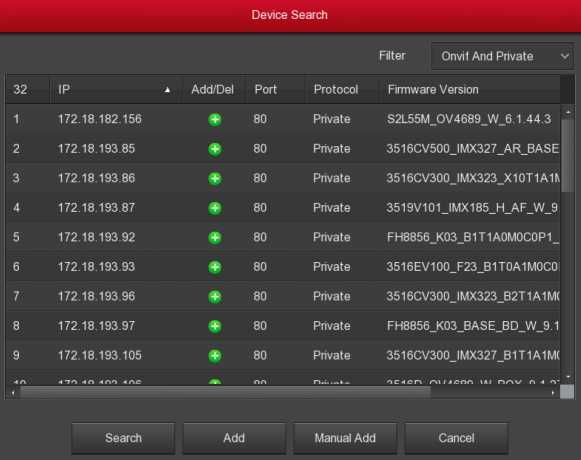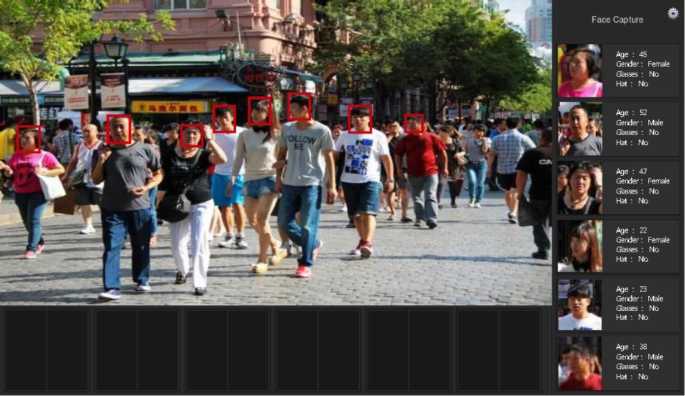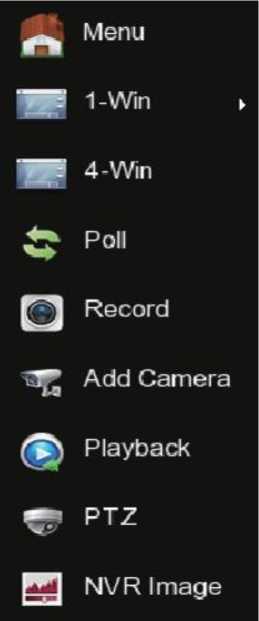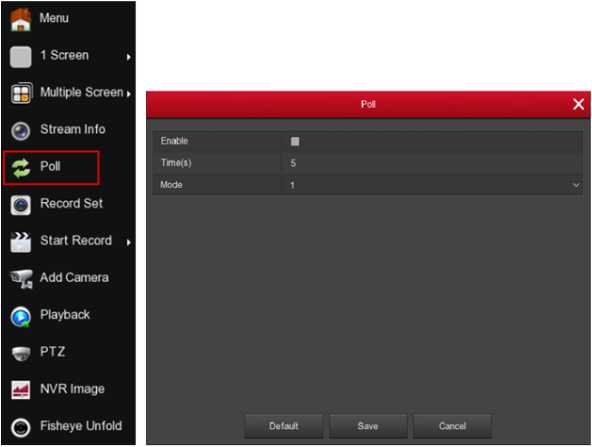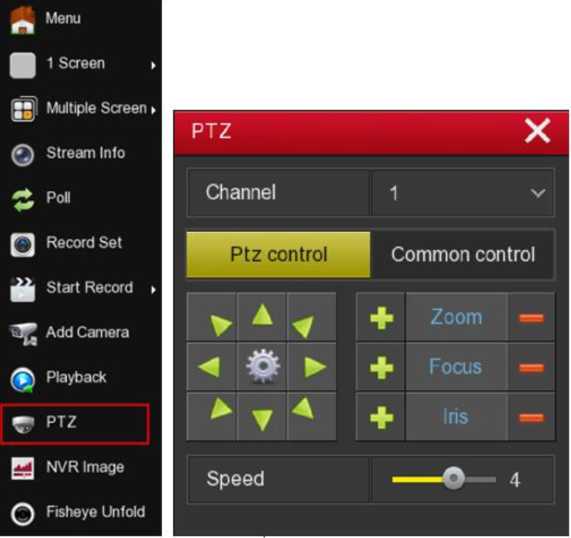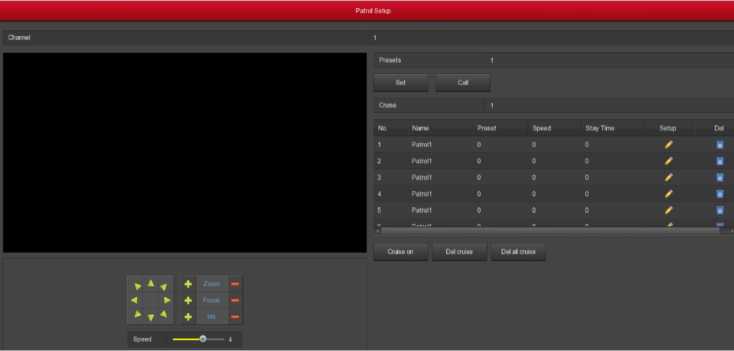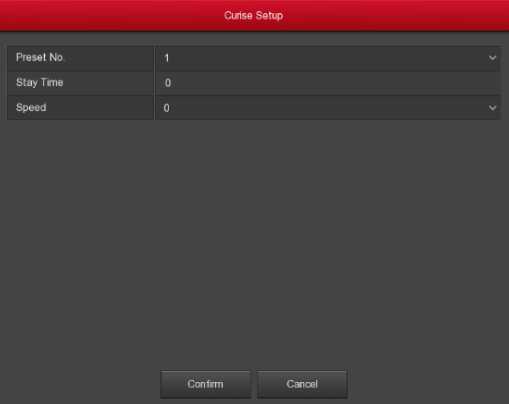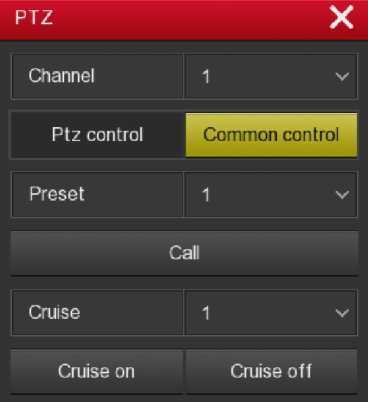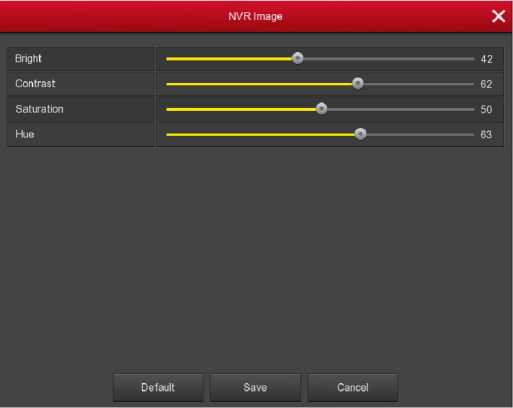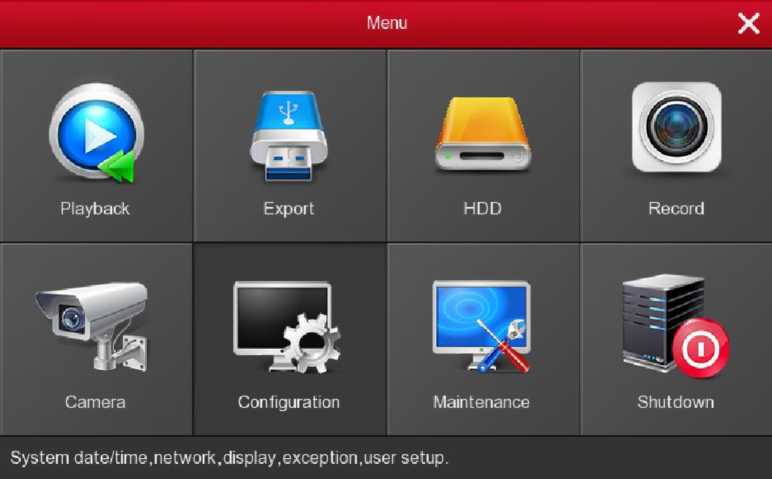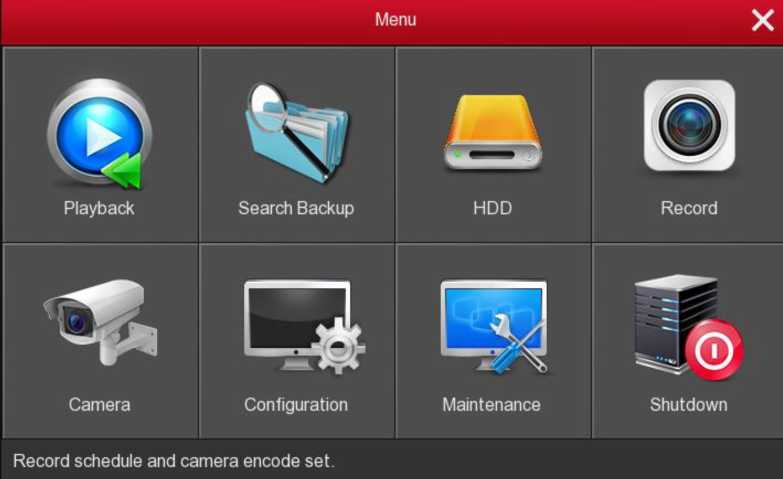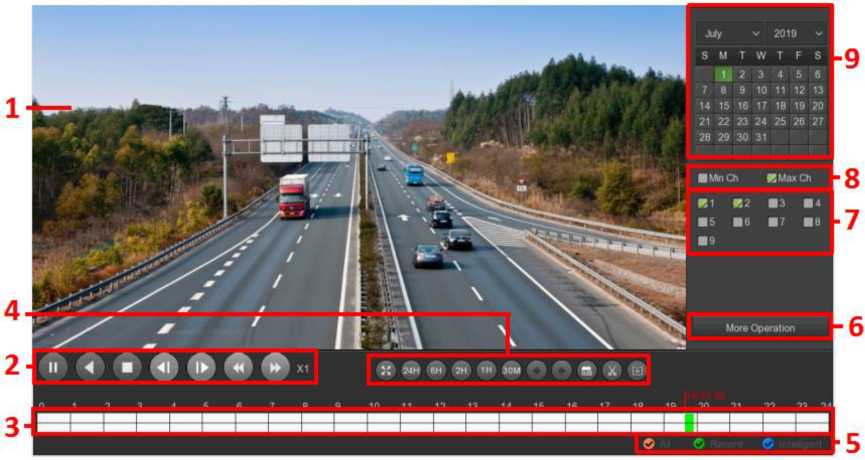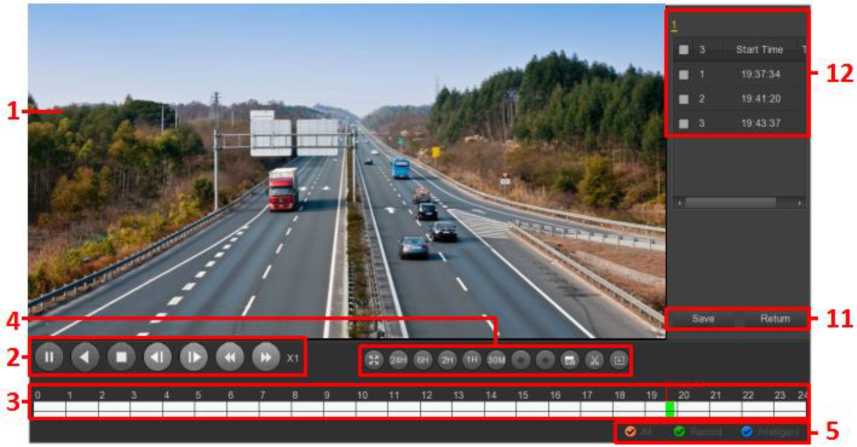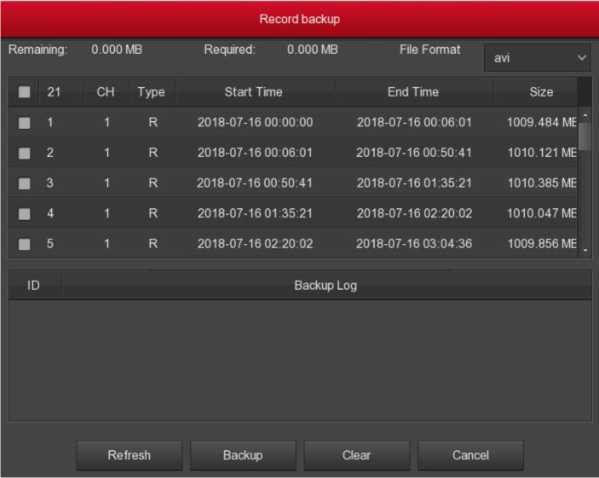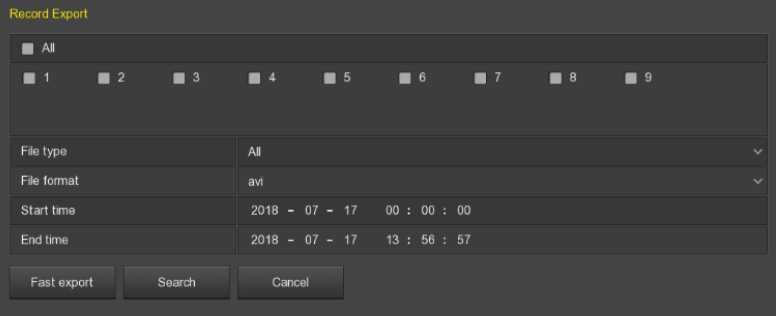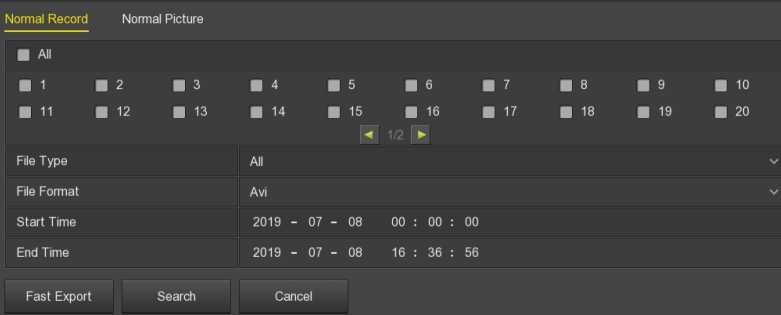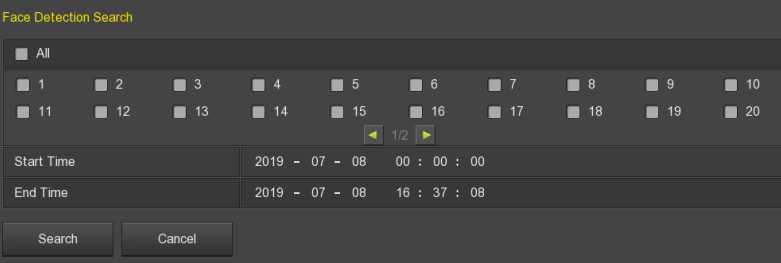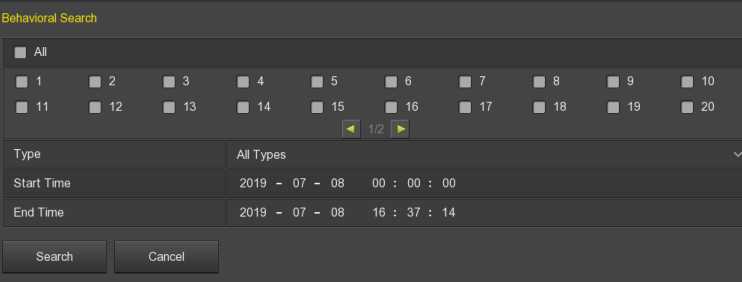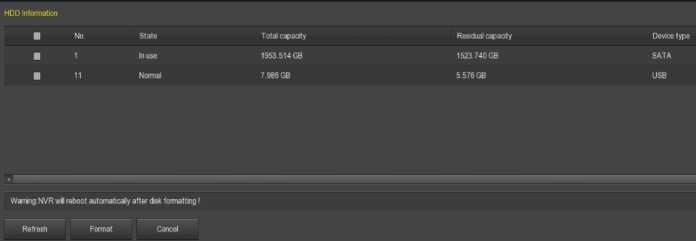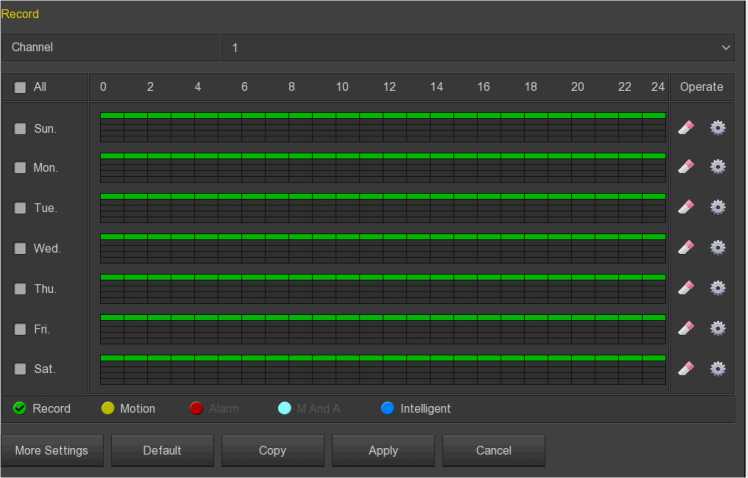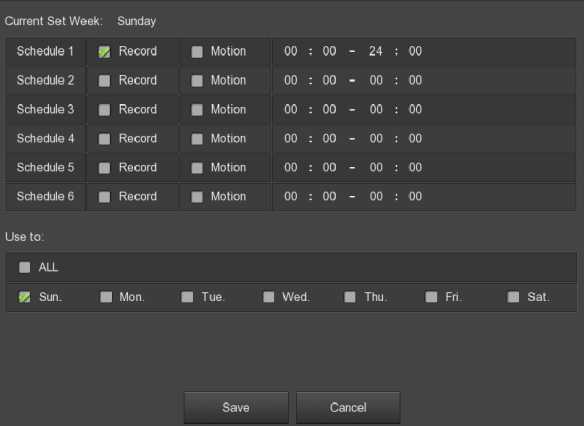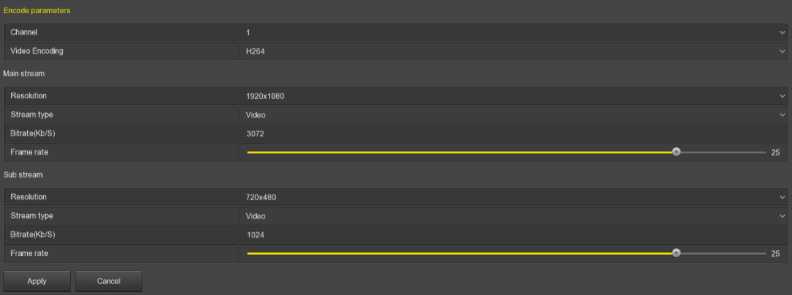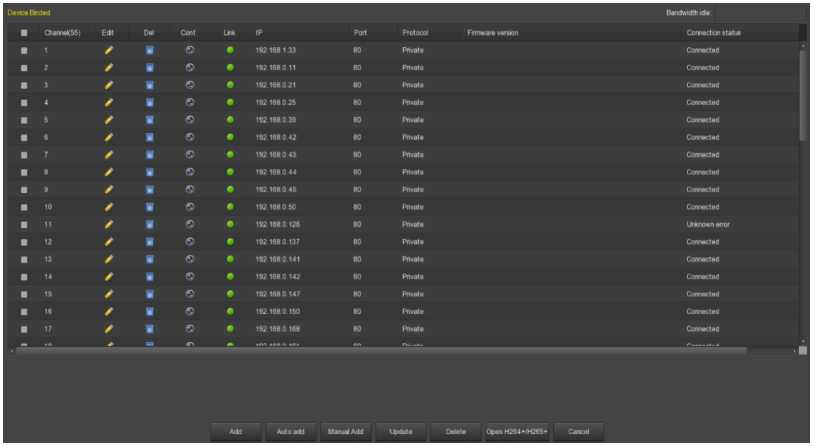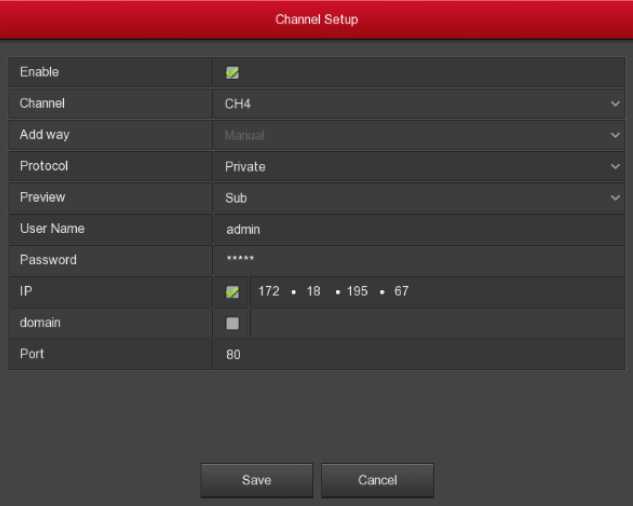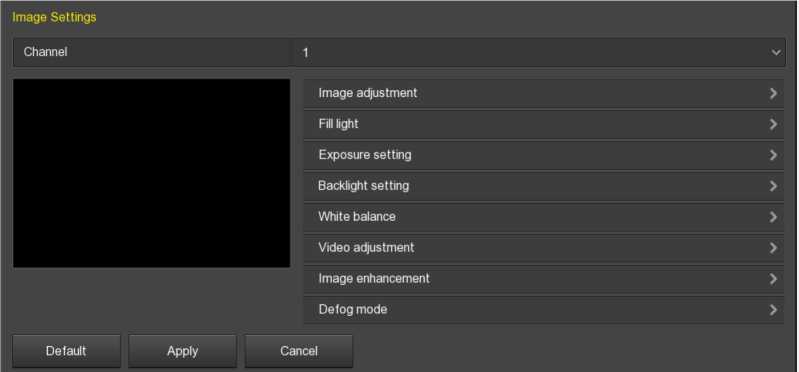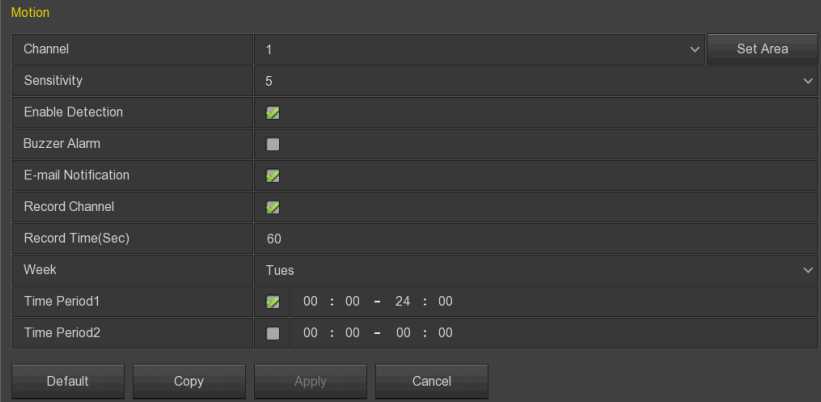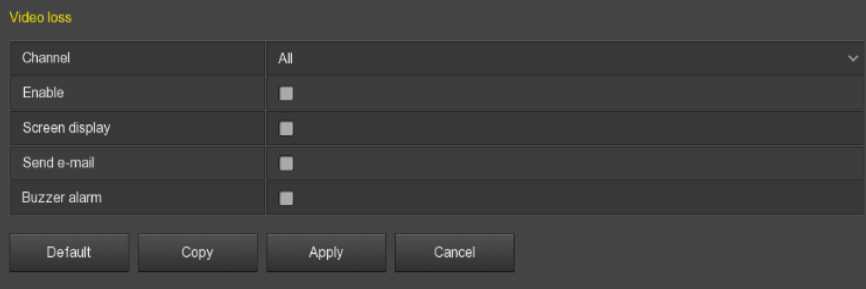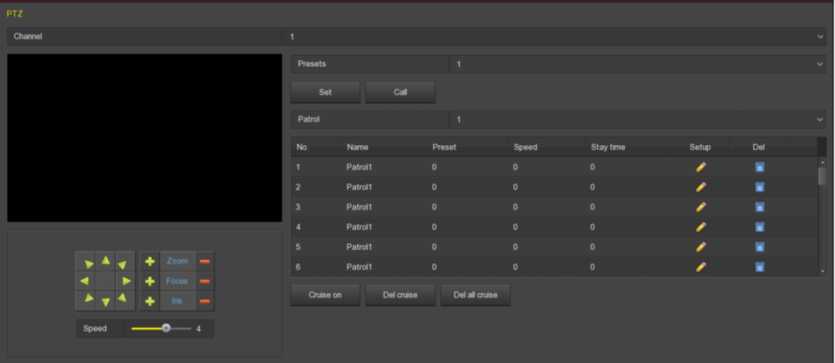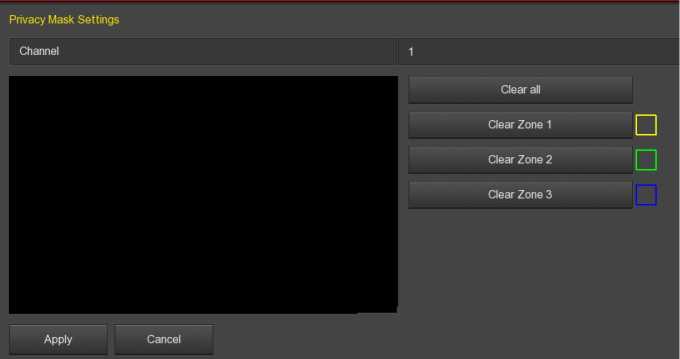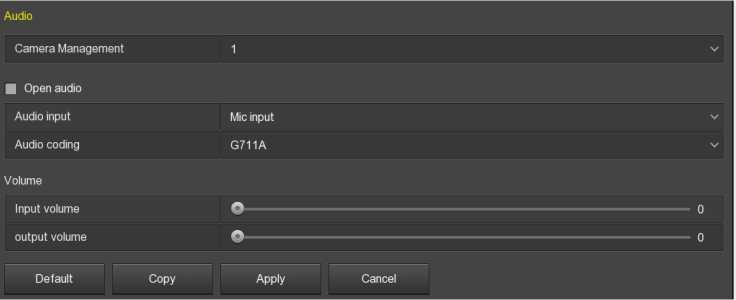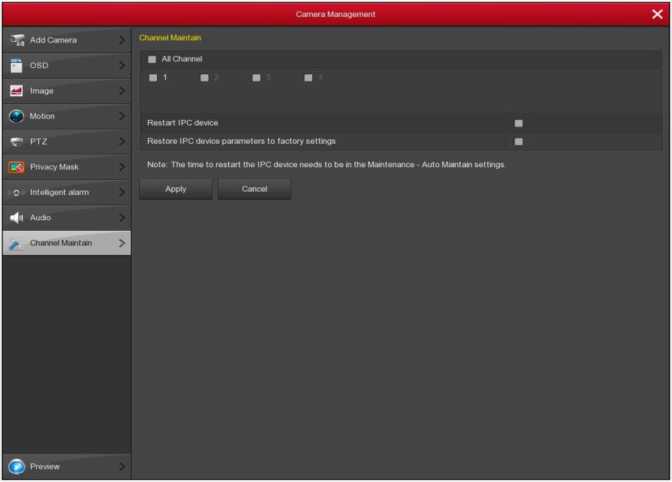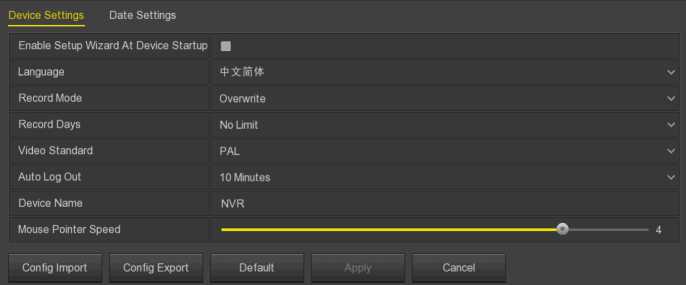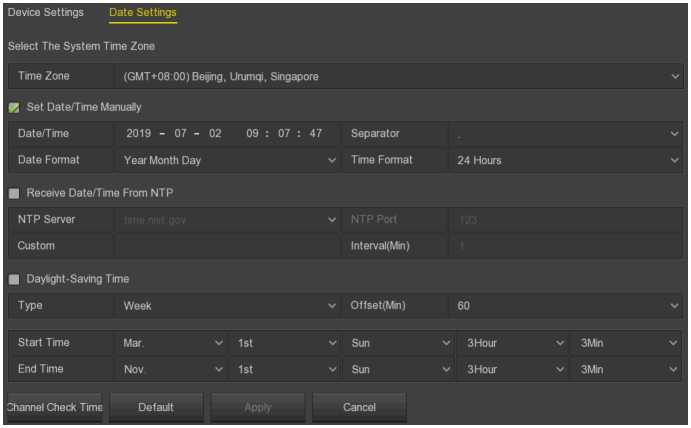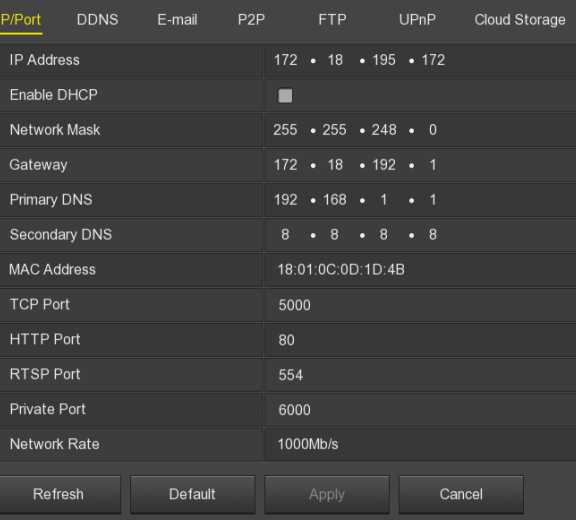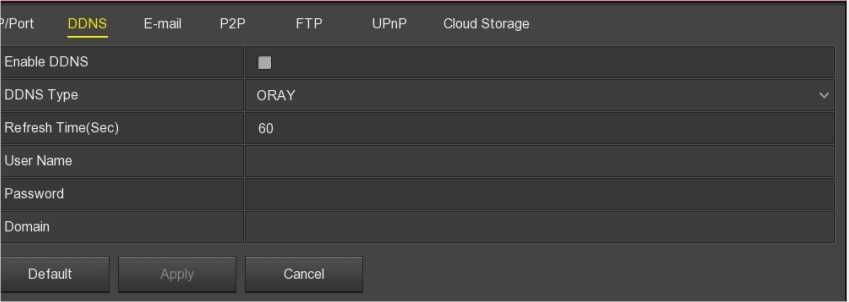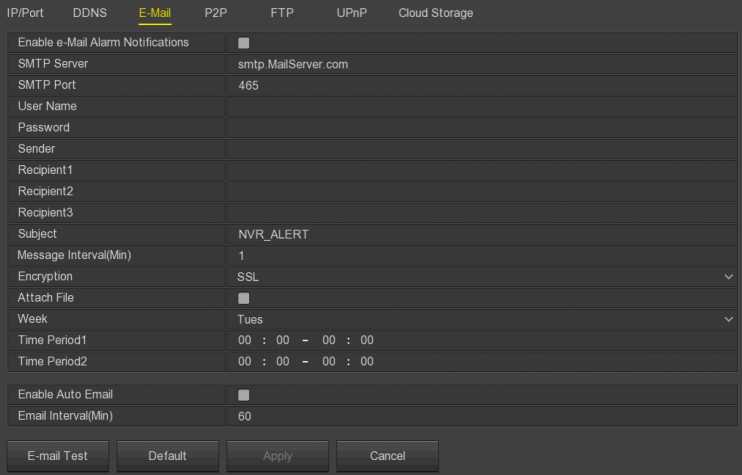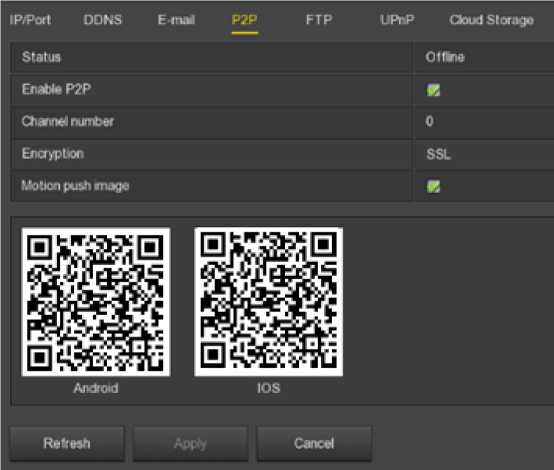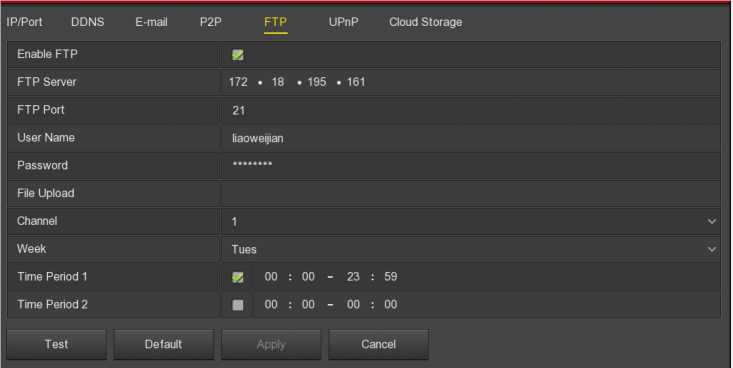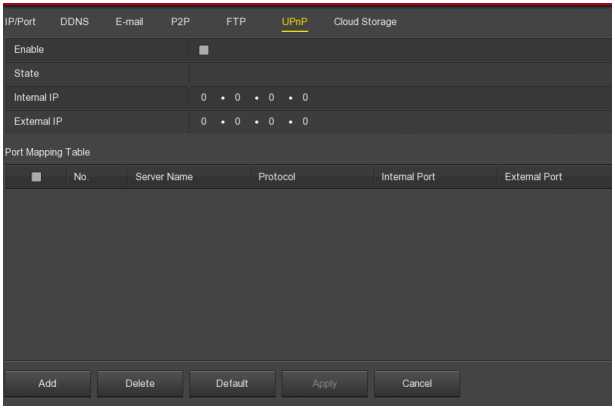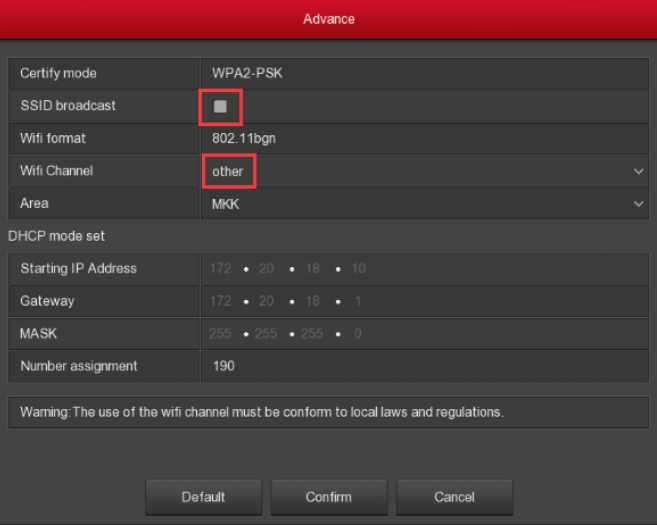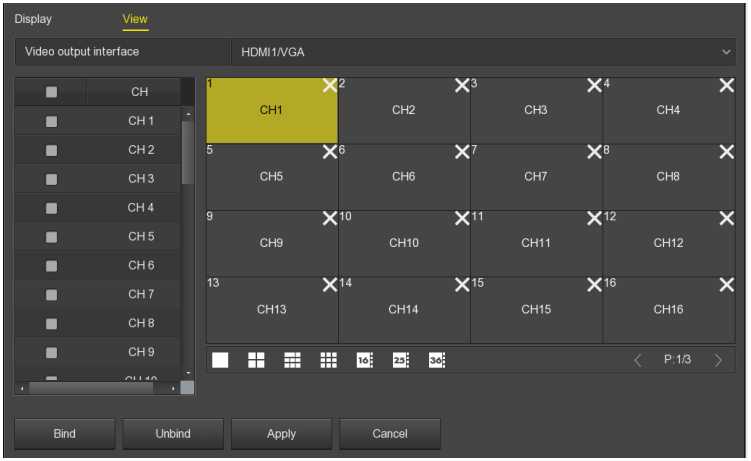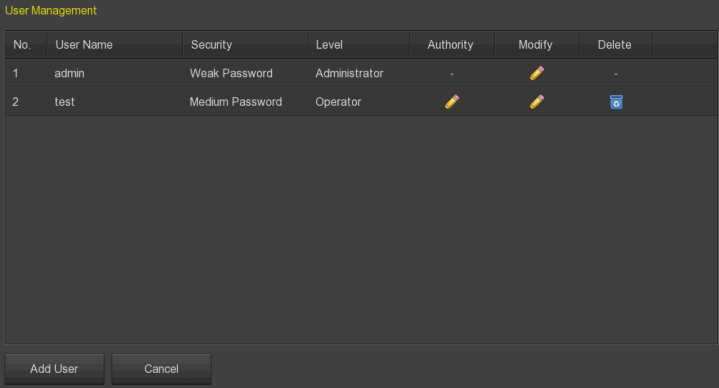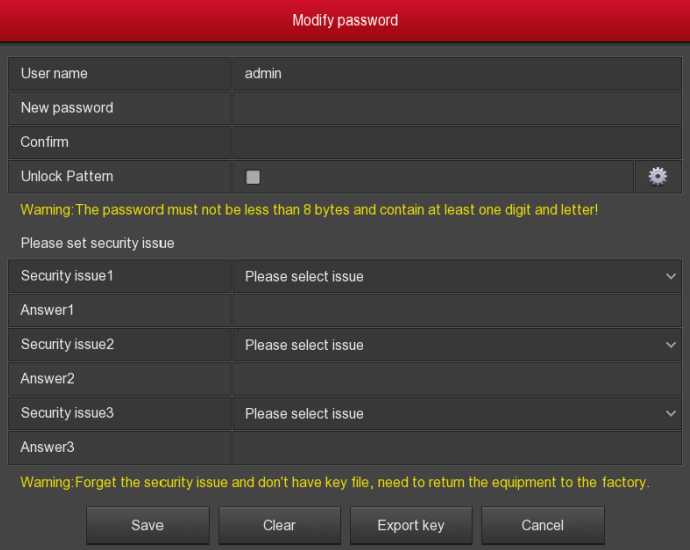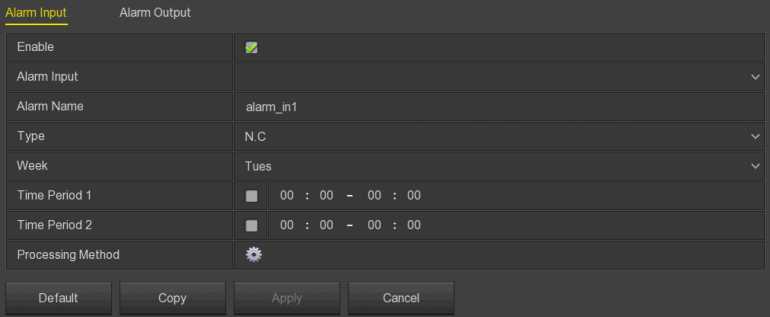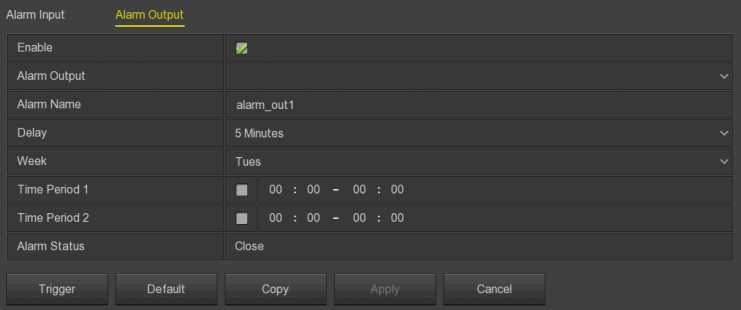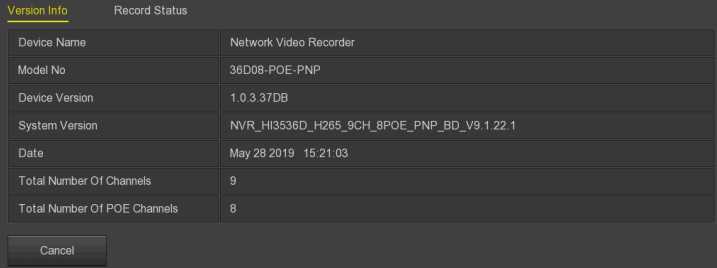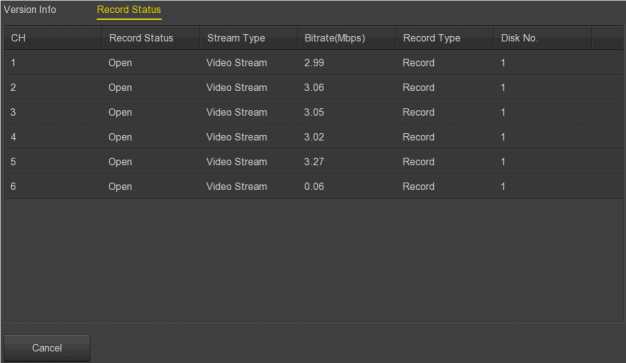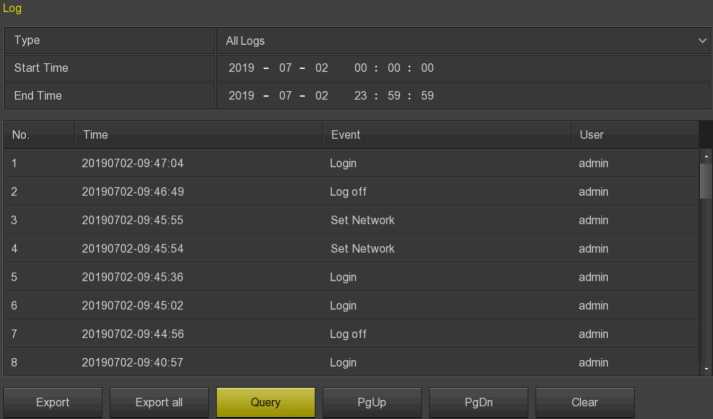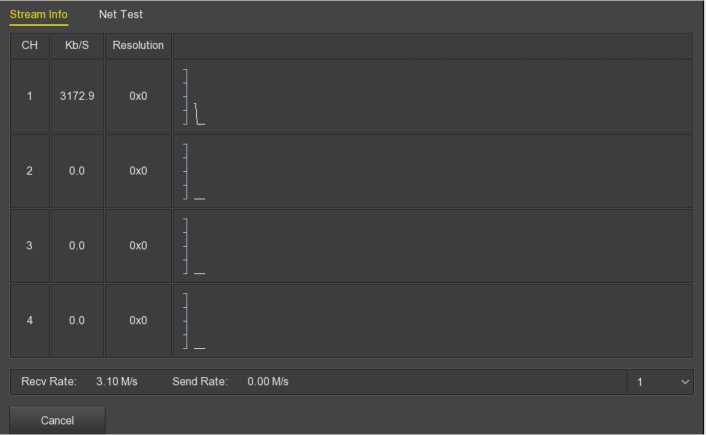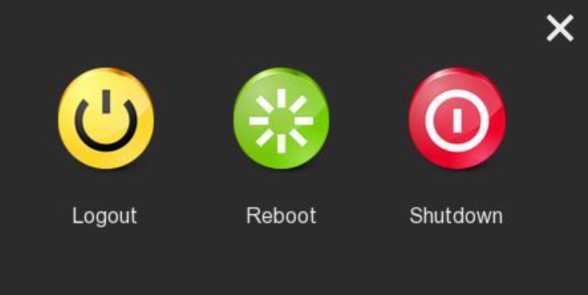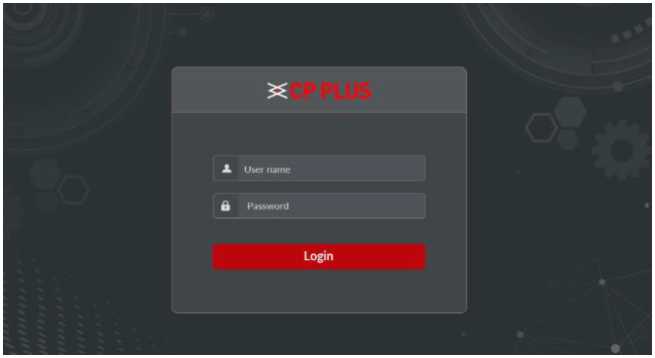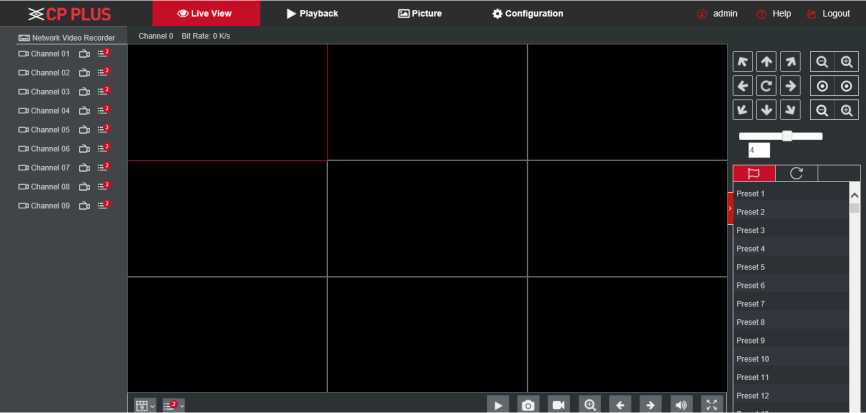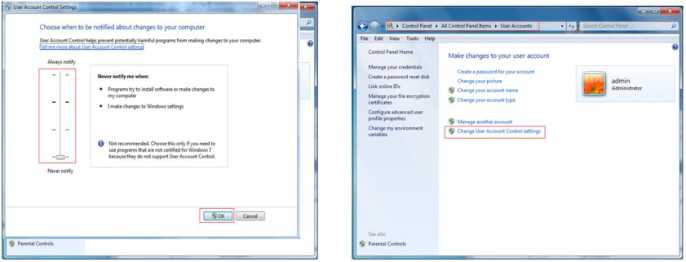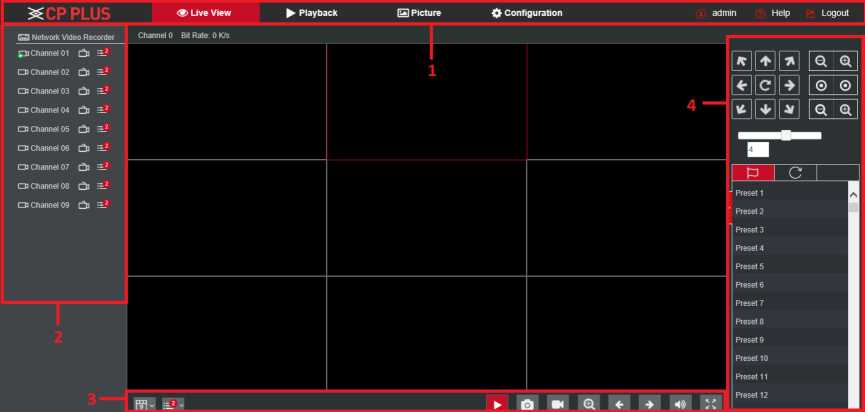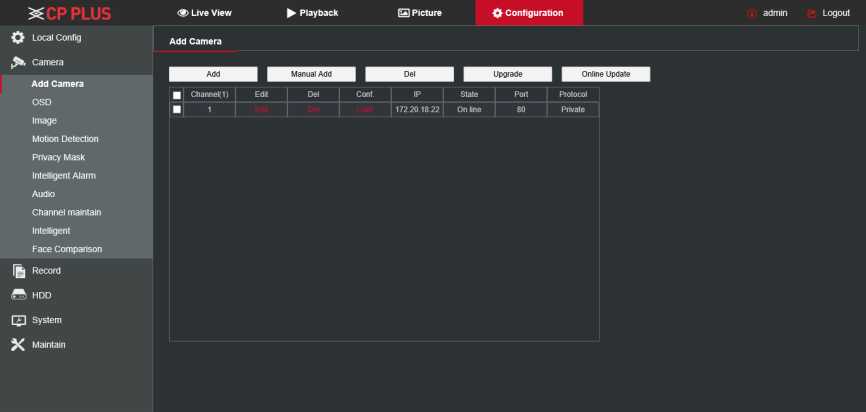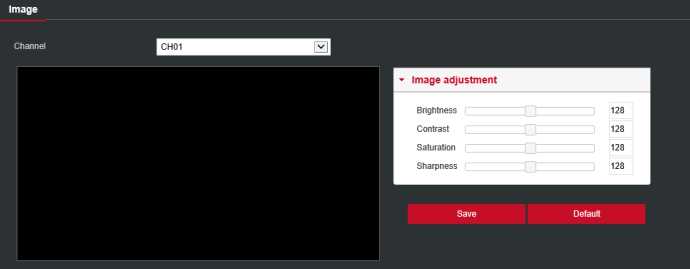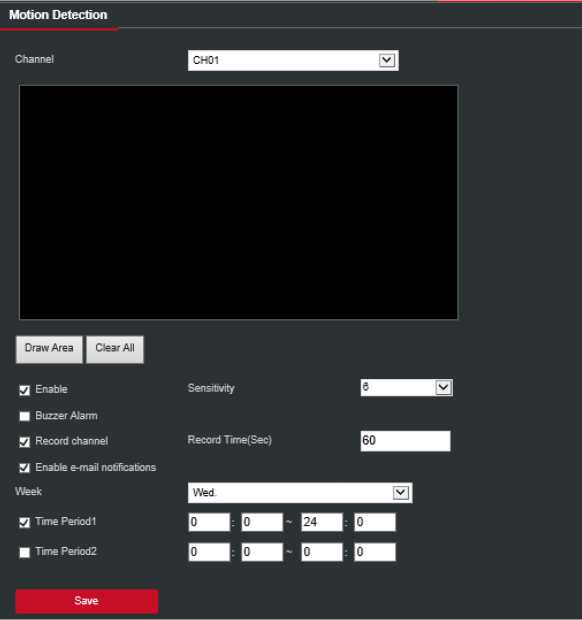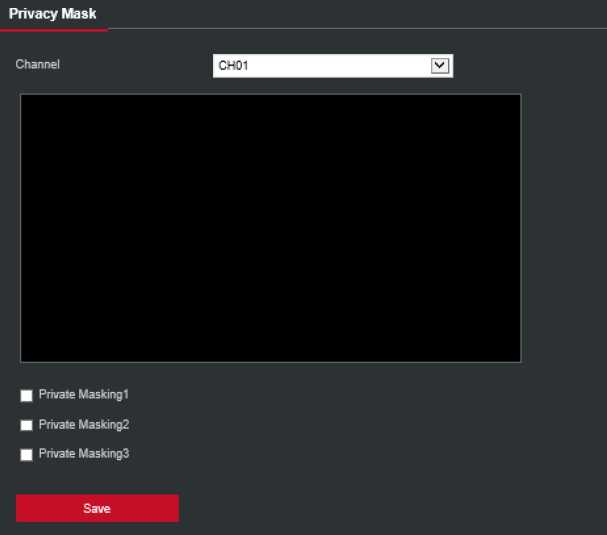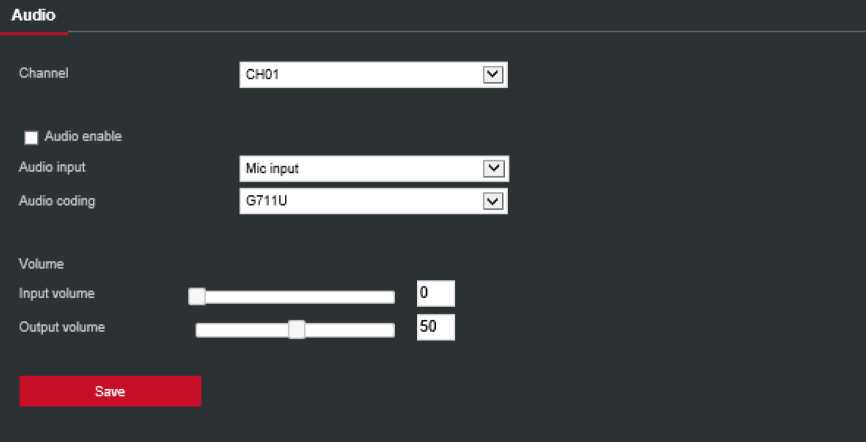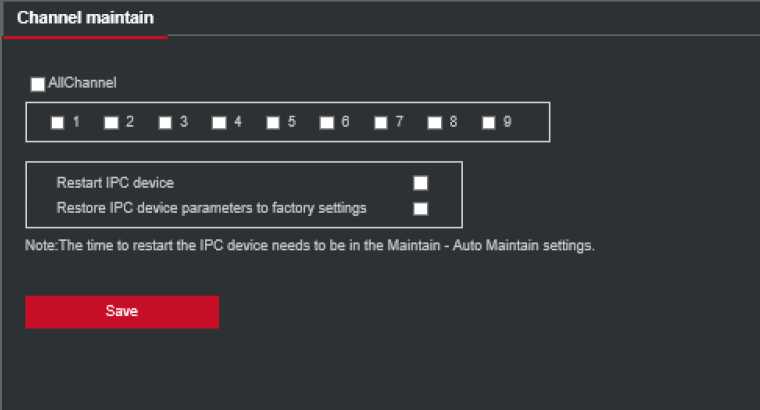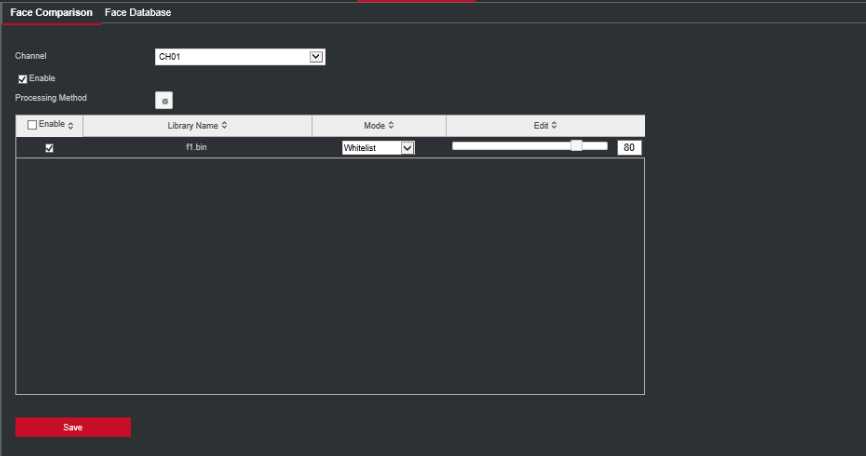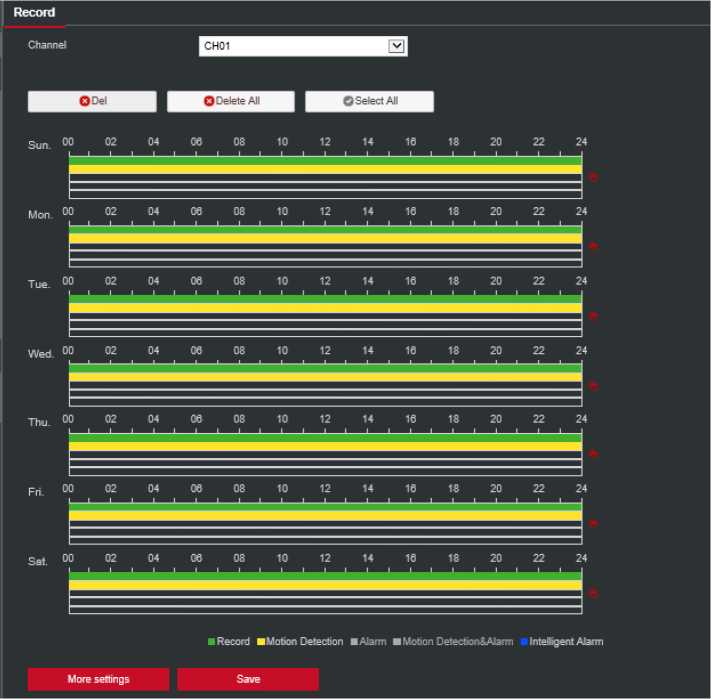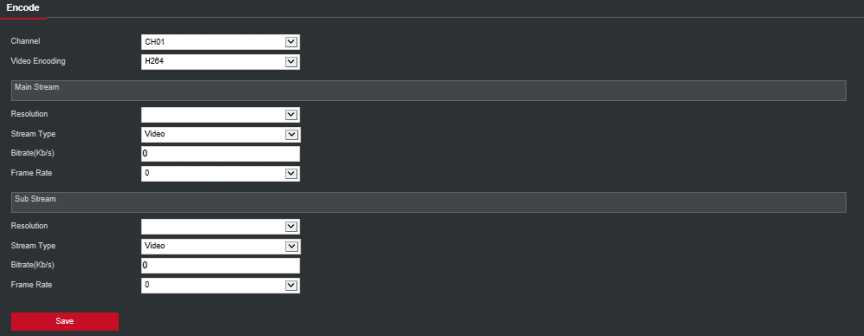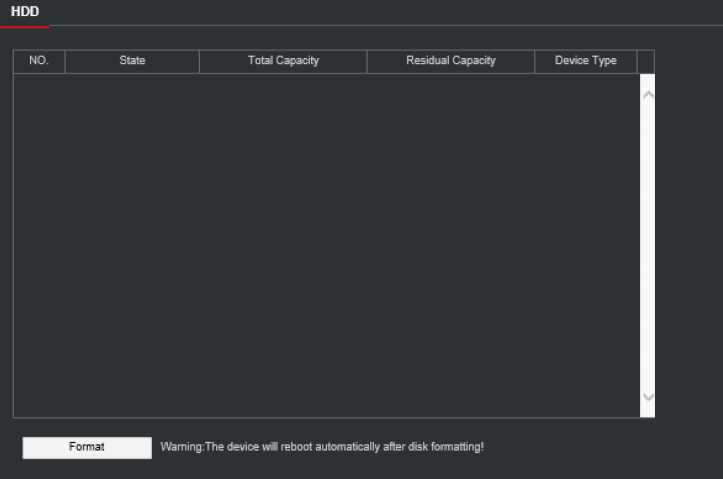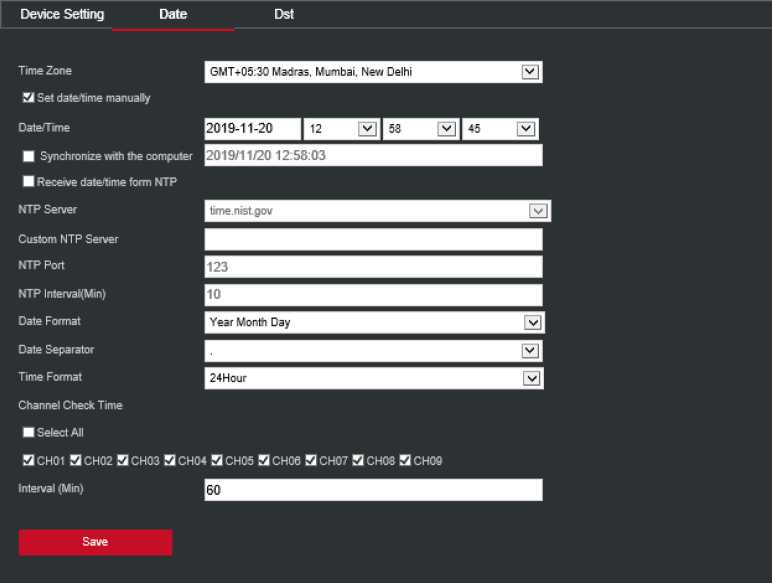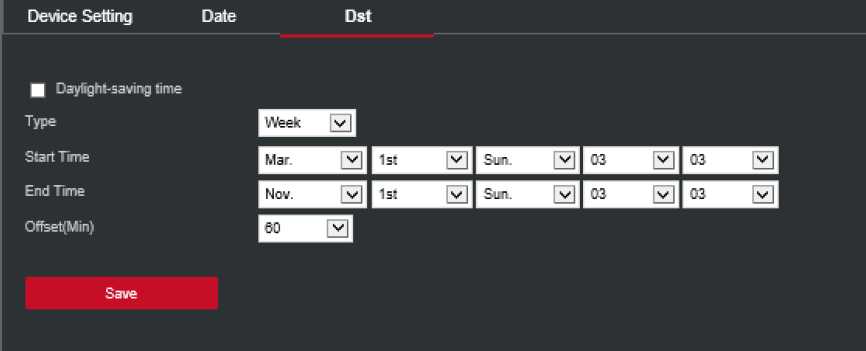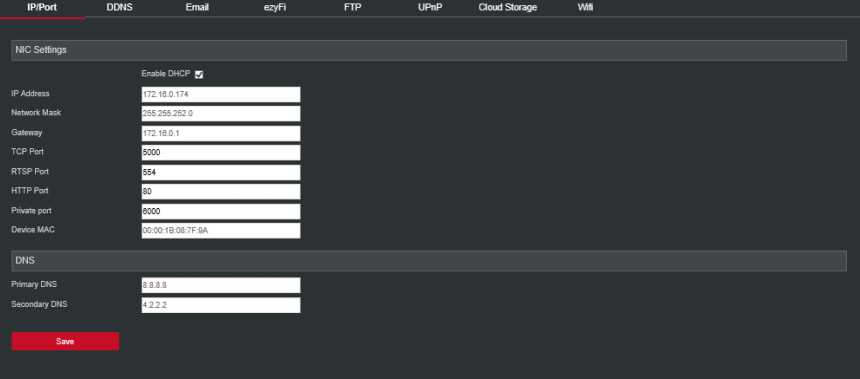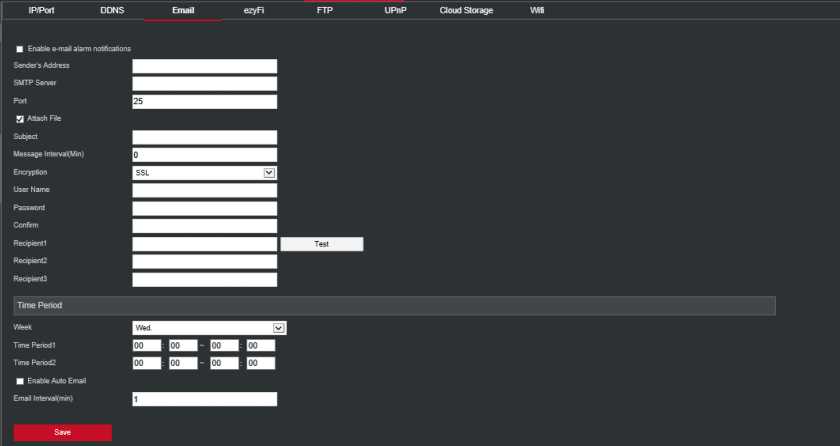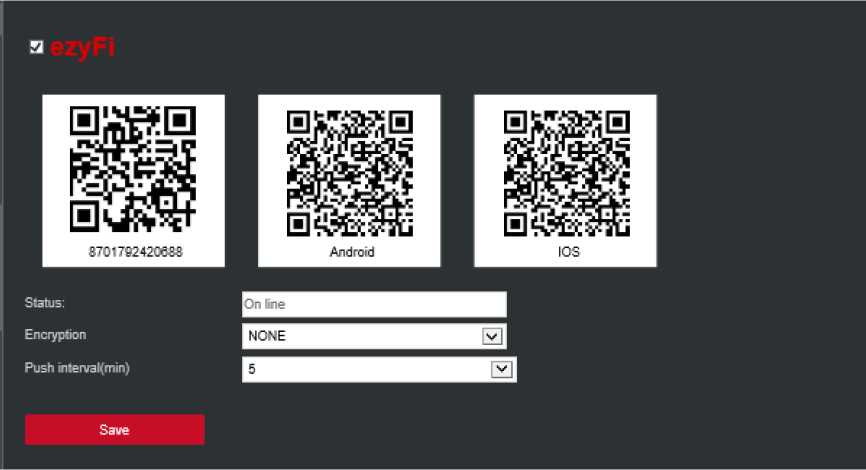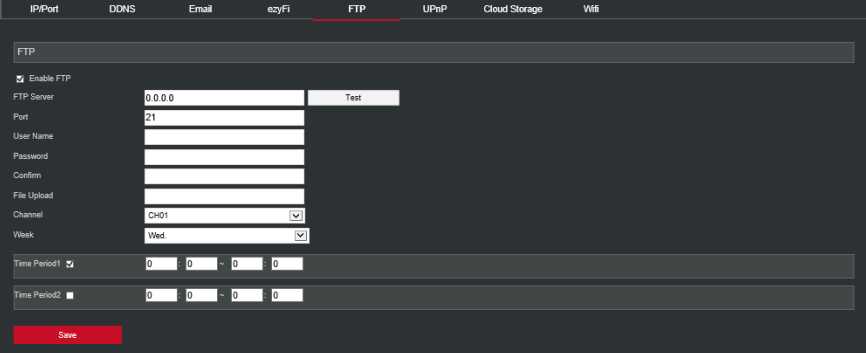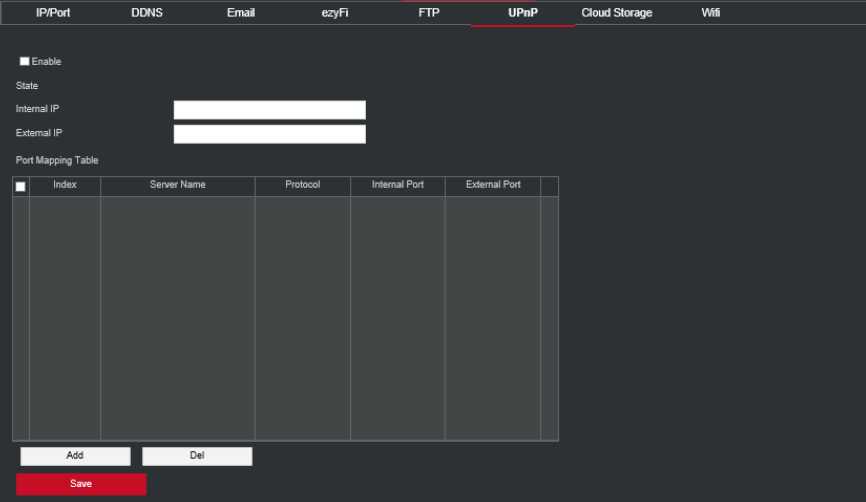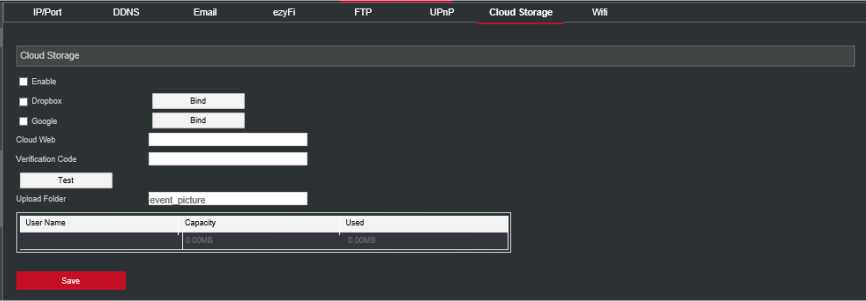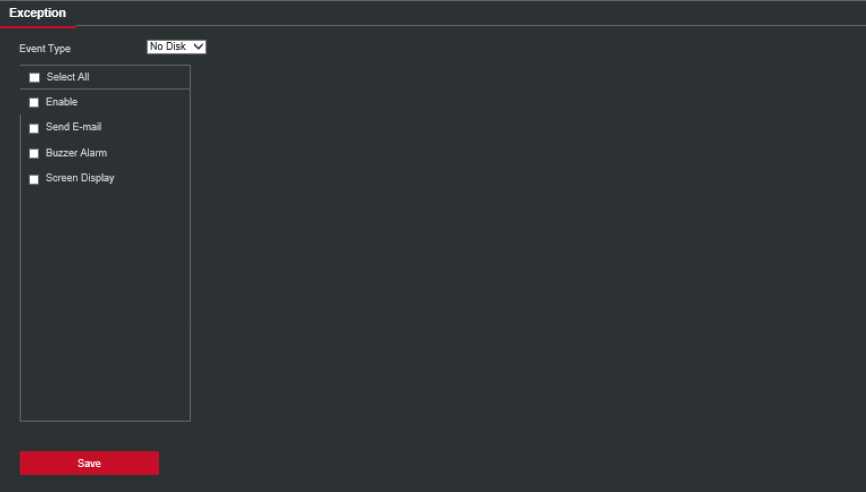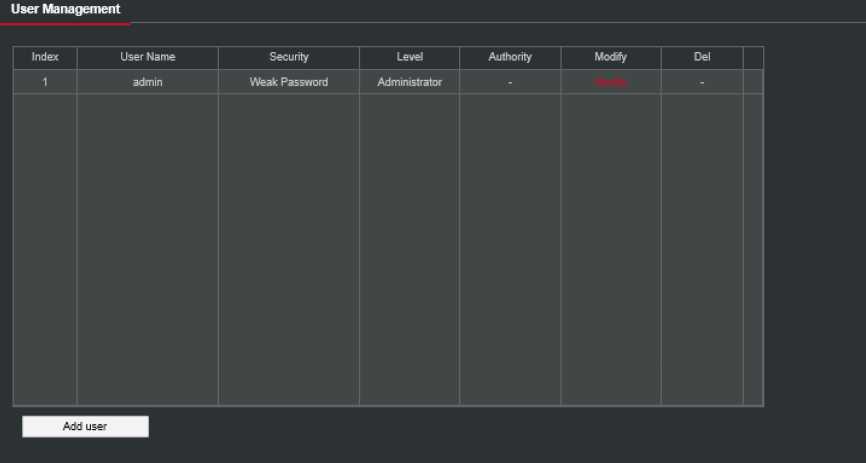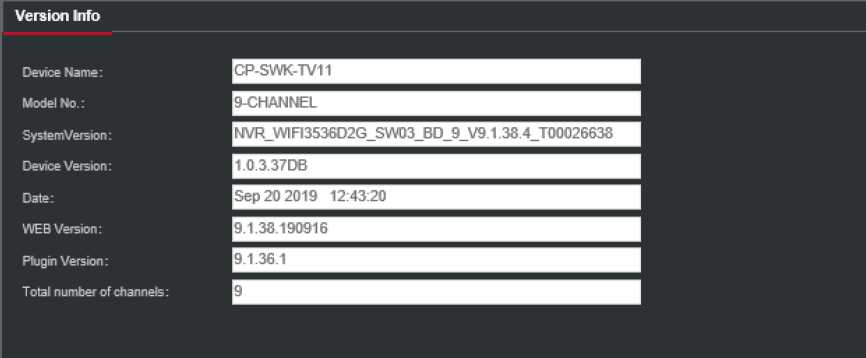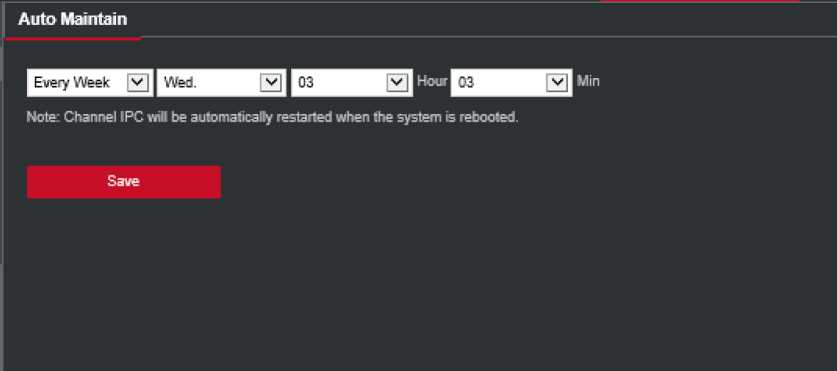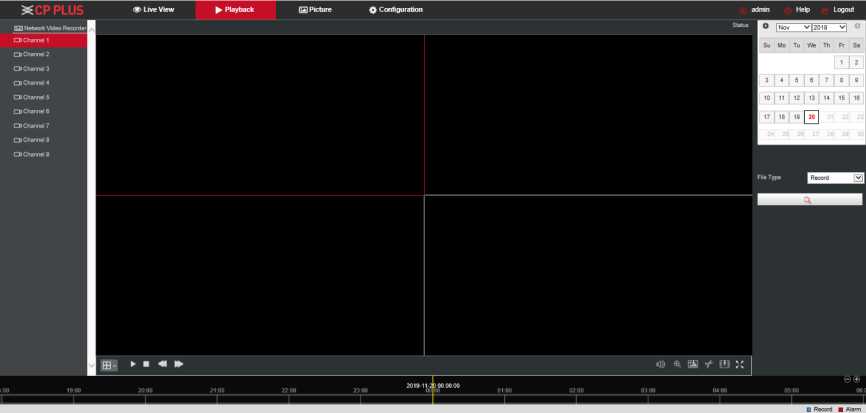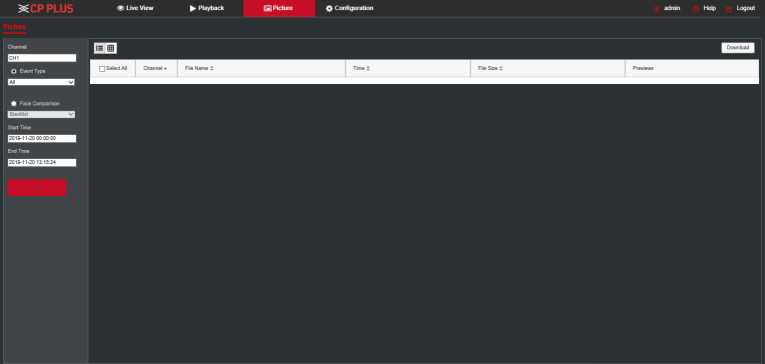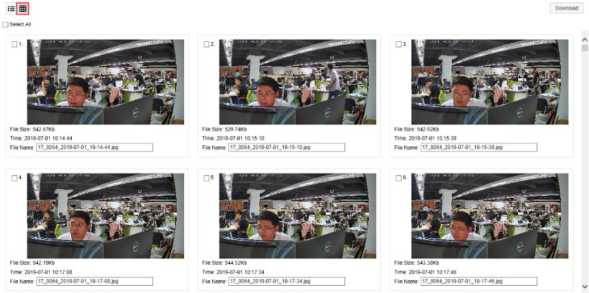Views: 14
ezyFi Wi-Fi Kit Setup Guide, Understanding the needs of our customers, CP PLUS has launched the EzyFi Series which presents a number of options. Each of these is a mix of EzyKam Cameras, Network Cameras, DVRs, and NVRs.
These options have been presented to suit different surveillance requirements of different places.
Functions Wi-Fi Support To eliminate the hassle of cables and switches, this cam-era has been wifi enabled which makes it easier and better to conduct surveillance of any closed space
ezyFi Wi-Fi Kit Setup Guide
Read More :
This product is a new generation of high-performance NVR (Net Video Recorder) independently developed by the company. It adopts several high-tech technologies, such as video and audio codec technology, embedded system technology, storage technology, network technology and intelligent technology. With local preview, video multi-screen split display, local real-time storage of video files, support for mouse shortcuts, remote management and control. This product supports two storage methods: front-end storage and client-side storage. The front-end monitoring point can be located anywhere on the network, regardless of geographical location.
It is combined with other front-end devices such as network cameras and network video servers to form a powerful security monitoring network with professional video surveillance system software. In the networked deployment system of this product, only one network cable can be used for the central point and monitoring point. Connection, center to monitoring point, no need to lay video lines, audio lines, etc., construction is simple, wiring costs, maintenance costs are low.
This product can be widely used in security, such as finance, telecommunications, transportation, electricity, education and other fields.
- The factory default super administrator account is admin and the password are admin.
- ezyFi NVR factory default IPv4 address: 192.168.1.245
- ezyFi NVR factory default Wi-Fi IPv4 address: 172.20.18.1
In order to simplify the description in this manual, the following conventions are made:
- The “device” mentioned in this manual mainly refers to the NVR.
- The “IP device” mentioned in this manual mainly refers to IPC, IP DOME, or DVS.
- The “channel” mentioned in this manual refers to the NVR’s IP channel.
- Click the “X” or “Cancel” button to return to the previous screen.
- Click All Interfaces Default to restore the current factory default settings.
- Click “Apply”, “Confirm” and “Save” on all screens to save the current settings.
- H.264 videos condense format, support 4K/6M/5M/4M/3M/2M/1080P
- /720P/D1 resolution network camera input.
- Some models support H.265 video compression format, support 4K / 6M / 5M / 4M / 3M / 2M / 1080P/720P / D1 resolution network camera input.
- G.711U and G711a audio condense format.
- Windows-style user interface embedded real-time Linux3.0 operating system.
- Support the standard ONVIF protocol.
- Support independent adjustment of coding parameters for each channel, including coding type, resolution, frame rate, and bitrate.
- Support the quick addition of IP channel functions.
- Support our smart IPC face detection, Crossover, Regional intrusion, people stay, people gathering and other intelligent detection access and linkage.
- Support manual capture and image playback.
- Three-level authority user management, administrators can create multiple operation users and set their rights, rights can be refined to the channel.
- Support video loss alarm, motion alarm, network disconnection alarm, IP conflict alarm, hard disk error and no disk alarm.
- Various alarms can trigger buzzing alarm, sending mail and screen display.
- Support preview, recording, play back, backup.
- Supports 3 streams.
- USB2.0 or USB3.0, support backup, software upgrading & mouse operating.
- The device only supports FAT32 and NTFS format U disk.
- Supports Chinese simplified, Chinese Traditional, Polish, Czech, Russian, Thai language, Hebrew, Bulgarian, Arabic, German, French, Portuguese, Turkish, Spanish, Italian, Hungarian, Roman, Korean, Dutch, Greek and Vietnamese switch.
- Some NVRs support dual-screen preview, face detection, whichever is the case.
Only one USB interface NVR needs to use USB interface such as Configuration import, Configuration export, backup, IPC Update, Manual Update, first select the corresponding function, such as click “Config import”, pop-up “Please insert the USB disk” 60 When the second countdown prompts, unplug the mouse and plug it into the USB device before the countdown ends. After the NVR recognizes the USB device, it automatically proceeds to the next step.
| Function | Function Brief Introduction |
| Real-time | Two video output, with VGA and HD interface, through the monitor, monitor to achieve monitoring, some models support TV, VGA, HD at the same time output. |
| Record | H.264 standard compression, timing recording. Some models support H.265 video compression standard. |
| Storage | Support SATA interface maximum capacity of 8T hard drive, video recording can be realized on the hard disk real-time storage function. |
| Playback | Support 1~4 channel playback and network multi-channel play back. |
| Backup | Support NVR backup to USB memory sticks, portable hard drive or network backup;
Support for VMS clip-by-clip backups |
| Network Operating | Support for remote client access, improve system safety. |
| Mouse Operating | Support USB mouse operation and can set mouse movement speed to set system parameters conveniently and quickly. |
| Pan-tilt Control | Though ONViF protocol, fulfill control functions of network dome camera. PTZ preset point, automatic cruise. |
| Motion Detection | By analyzing the video image, when the system detects that there is a movement signal that reaches the preset sensitivity, the motion detection alarm is started, and the linkage function is started. |
The schematic diagram of the front panel of the common equipment is as follows:
Figure 2-1
The corresponding description of each interface in Figure 2-1 is shown in the following table:
| No. | Name | Description |
| 1 | Hard disk indicator | Shows whether the hard drive is connected properly |
| 2 | Network Indicator | Shows whether the device is properly connected to the network |
| 3 | Power Indicator | The device is powered on normally |
| 4 | USB2.0 | Connect mouse or USB memory stick backup |
The panel diagram does not reflect the product size and ratio. Please refer to the actual product for details.
The schematic diagram of the rear panel of the common equipment is as follows:
Figure 2-2
The corresponding description of each interface in Figure 2-2 is shown in the following table:
| No. | Name | Description |
| 1 | Ethernet port | Connect Network |
| 2 | VGA | Connect VGA display devices such as computer monitors |
| 3 | HDMI | Connect HDMI display devices such as TV Display |
| 4 | Antenna | To broadcast Wi-Fi Signal |
| 5 | Power Connector | Device power connector |
The panel diagram does not reflect the product size and ratio. Please refer to the actual product for details.
Mouse instruction Operate NVR through mouse left button, right button and scroll wheel.
| Mouse Actions | Function |
| Click left mouse button | ✓ Select one of the options.
✓ Insertion cursor, enter or modify the value of a parameter. |
| Click right mouse button |
|
| Single, double-click the mouse left button |
number, bit stream value and user password) or user names. |
| mouse movements | Select the menu or menu item. |
| Mouse drag | Drag progress bar to playback video. |
| Slide mouse scroll wheel | ✓ Time setting.
✓ Select the drop-down menu values |
Input method includes lowercase and uppercase English letters. Clicking “ ” ” button on the
<3
left can switch the input method and the symbol ” ” represents deleting incorrect input.
Uppercase English input
1 234567890
qwer tyu i op
a s d f g h j k I
Q zxcvbnrïiG
*+ = : Space < > Enter
Lowercase English input
Notice
Before installation, please confirm that the power has been disconnected.
Please use the NVR dedicated monitor hard drive recommended by the device manufacturer.
A Phillips screwdriver
The hard disk is installed as shown in Figure 3-1.
- Loosen the fixing screw on the cover, open the cover.
- Connect one end of the hard disk data cable and power cable to the motherboard and connect the other end to the hard disk. Align the four positioning screw holes at the bottom of the hard disk with the hard disk positioning holes at the bottom of the chassis.
- Hold the hard disk with hand, turn over the chassis, and fix the hard disk with screw at the indicated position.
- After hard disk installed, turn over the chassis, fix the cover with screw.
Use VGA cable or HDMI cable to transmit the NVR signal to the display. If user want to access through Network or Internet like on Laptop or Mobile app (ezyFi) then have to connect ethernet cable to NVR and share internet. As show in Figure 3-2.
The steps to turn on NVR are as follows:
- . Connect the device to the monitor and plug in the mouse and power cord.
- . Turn on the power switch on the rear panel to start the device. The system initialization
screen appears, as shown in Figure 4-1.
Figure 4-1
- Please confirm that the voltage to be connected matches the NVR requirements and ensure that the NVR ground is well grounded.
- If the power supply is abnormal, the NVR may not work properly or even damage the NVR. It is recommended to use a regulated power supply for power supply.
- The illustrations that appear in the operation manual may not be the same as the menu interface displayed on your monitor, so all illustrations are for user’s reference only.
- After the device starts up, it can be simply configured through the boot wizard, which is the normal operation of the device.
Quickly configuration the NVR as shown in Figure 4-2.
Figure 4-2
- Then select a user name, enter the user password, select the system language and click “Login” to login the system (the default username is admin, password is admin), as shown in Figure 4-3.
Figure 4-3
- When the login password is too simple, a security password prompt will pop up. Click “Modify “. As shown in Figure 4-4.
Tip
The current password is too simple,please modiiy
the password!
Modify Modify later
Figure 4-4
Click the “New password” box, enter a new password, confirm the new password, select the
security question, enter the corresponding answer, click “Save”; insert a USB flash drive on the
device, and click “Export key”. As shown in Figure 4-5.
Figure 4-5
Unlock Pattern: Check “Unlock Pattern”, draw the unlock pattern through the mouse, draw the pattern again for confirmation, complete the unlock pattern settings.
- Go to the “General” interface, configure the Device setting and date, and click “Next Step”. As shown in Figure 4-6.
Figure 4-6
Go to the “Network” interface, configure the network parameters of the device. Click
“Next Step”. As shown in Figure 4-7.
Figure 4-7
Go to the “Add Camera” interface, you can search for and add devices and click “Next Step”. As shown in Figure 4-8.
Figure 4-8
- Go to the “Record Setup” interface, set the video plan, support the manual drawing schedule, click “Complete”, the boot wizard is set up. Interface as shown in Figure 4-9.
Figure 4-9
On the startup wizard screen, click Cancel to exit the startup wizard.
When the password is too simple, after the login, a password strength security interface will pop up. You can click “Modify later” to continue using the existing password.
Please confirm that the XVR device has been properly connected to the network before setting up the network parameters.
System default setting is all channels are recorded 24 hours a day.
If the boot wizard has been configured for the first time, click “Menu ^ Configuration ^ General”, cancel check “Enable wizard at startup”, and the boot wizard interface will no longer appear after the next boot.
If you forget your password, you can click “Forget password” on the login page to enter the safety verification interface to reset the password, interface as shown in Figure 4-10. The password can be reset via “Answer the question” or “Import Key”.
Figure 4-10
Answer the question: Select the three security questions when setting the password and enter the answer to the corresponding question to enter the new password setting, interface as shown in Figure 4-11.
Figure 4-11
Import key: Select the authentication method as Import Key, as shown in Figure 4-12.
Figure 4-12
- Insert the USB disk (the key file exported when the device setting password is stored) on the device and click Import to import the key file into the device.
- In the modification user interface, select “Change Password”, enter a new password, confirm the password, and click “Save”, as shown in Figure 4-13.
Figure 4-13
When you select “Security Issues”, the issues and answers must exactly match the settings when you set the password to proceed to the next Modify User screen.
When you select “Import Key”, the key file in the USB flash drive must be the key file that was exported when the password was set.
After the system is fully booted, it will enter the default preview interface, as shown in Figure
Figure 4-14
After the device normally starts up, the default setting is to preview in multi-screen display mode. Products with different channels has different amount of split screens to display. On the preview interface, you can set the appropriate date and time. On the bottom left of the screen, it shows the recording status of each video channel or alarm status icon.
The function of each icon is shown in the following table:
| Icon | Function |
| The monitoring channel is in video. | |
| 4 | The monitoring channel is in the motion detection state. |
| «1» | The monitoring channel is in the state of intelligent alarm |
Quick add device is shown in Figure 4-15.
1.
At the preview menu, for the channel of unconnected IP Camera, click anywhere in the
channel interface, the lower right corner of the channel display “ ” icon.
Figure 4-15
2. Select the device to add and click Add . Interface as shown in Figure 4-16.
Figure 4-16
- Search: Click to search all online IP devices in the LAN according to the protocol in the “Display Filter” box.
✓ Add: Add selection device.
- Manual Add: For details on how to manually enter device information.
- Filter: Sort the filter display in the device that has been searched.
Filter Search Add Device: In the Add Device interface, select the corresponding protocol in the “Filter” column ^ Search ^ Select Device ^ Click “Add”.
Manual Add: On the Add Device screen, click “Manual add” ^ Click “Enable check box”^ Select Protocol, Preview Stream, Enter Password, IP, Port ^ click “Save”.
After adding a device to a channel, click the channel. The shortcut menu appears as shown in Figure 4-17 and Figure 4-18.
Figure 4-17
Figure 4-18
The function of each icon is shown in the following table:
| Icon | Function | |||
| Z | Manual capture clicks the button to capture the current video pictures. Search, view and backup pictures can be carried out in “Search Backup” -^ “Normal Search”^ “Normal Picture”. | |||
| o | Face detection, click to enter the face detection interface. | |||
| 0 | Screen rotation button, click the button, the screen clockwise 90 ° rotation, click the button again, the screen clockwise 90 ° again. | |||
| 0 | Instant playback button, click the button, the channel playback 5 minutes before the video. | |||
| Audio output control button, click to set the channel output volume and mute. | ||||
| * /
(Wi-Fi NVR |
■ a
) |
Electronic zoom button, click to open the electronic zoom function, press and hold the left mouse button to select the zoom area, release the mouse, the preview interface is displayed as the selected zoom area, click the right mouse button to exit the electronic zoom and restore the live preview interface. | ||
| 1
Q 1 |
Electronic zoom button click to enter the full-screen zoom mode, display the unmagnified image of the channel in the lower right corner of the screen, and drag the red frame of the unmagnified image by mouse to switch the position of the enlarged image. Click “^^S” and “^^S” or scroll the mouse wheel to adjust the zoom. multiple. Click the right mouse button to exit the electronic zoom and restore the live preview interface. | |||
| ¿J | Image colour button, click into the image interface, you can set the channel brightness, contrast, saturation, sharpness of the parameter values. | |||
| e | Bit stream information button, when the mouse moves to the icon position, the channel shows the current stream and other related parameters. | |||
| K | Image channel shortcut menu close button, click to close the image channel menu. | |||
Click ” ” in the channel shortcut menu to enter the face detection interface, as shown in Figure
4-19 below.
Figure 4-19
The face detection interface displays the detected face on the right and bottom of the interface, and displays the device’s judgment on whether the person’s age, gender, and whether to wear glasses or a hat are bearded.
Click “’O” to enter the setting interface, you can set the snap face attribute parameters (age, gender, glasses, hat and beard).
The image shortcut menu appears only if you click Channel after adding the device to the channel.
Some NVRs support preview electronic zoom to switch to full screen and can be zoomed in and out with the mouse wheel.
The face detection function is only valid for the IP channel of the face detection function.
Log in system, right-click it to pop up the NVR shortcut menu. As shown in Figure 5-1, you can enter the Main Menu, preview screen, stream information, Poll, record setup, start record, add device, playback, PTZ setup, NVR image, etc.
Figure 5-1
- Main Menu: Click and enter the main menu.
- 1-Win: Display all channel numbers of the device (CH1, CH2, CH3…CH36), click to select a
channel, and the preview interface will display the channel monitoring screen.
- 4-Win: Divided into nine groups showing all channel numbers, each group of 4 channels (CH1-
CH4, CH5-CH8, CH9-CH12, CH13-CH16, CH17-CH20, CH21-CH24, CH25-CH28, CH29-CH32, CH33-CH36), click to select a group, and the preview interface 4 screen shows the group 4 Monitoring screen for each channel.
- Multiple Screen: Some devices that support multiple channels have more screen splits. Except for 1 screen, other split screens are hidden in the multi-screen menu.
- Stream Info: Click into the stream information interface to view the stream information of the corresponding channel (such as resolution, frame rate, bit rate, encode type, IP address, record status, protocol, etc.).
- Poll: Click into the poll setup interface (Detailed operation as 5.1.1).
- Record Set: Click into the record setup interface (Detailed operation as 5.3.4).
- Start Record: Click to open the recording menu to quickly set up 24-hour normal recording or motion detection recording for all channels.
- Add Camera: Click and enter the add camera configuration menu (Detailed operation as 5.3.5.1).
- Playback: Click into the Playback interface. (Detailed operation as 5.3.1).
- PTZ: NVR supports PTZ control, allowing users to remotely control the camera. (Detailed operation as 5.1.2).
- NVR Image: Click into the image color configuration interface. (Detailed operation as 5.1.3)
Multi-screen display depends on the maximum number of channels supported by the device. For example, there are 9 screens in the shortcut menu of the 9-channel device and 16 screens in the 16-channel device shortcut menu^
The 64-channel NVR supports dual-screen preview device real-time video, in which interface HD1 and VGA are the main screen interfaces, and HD2 is the auxiliary screen interface. In the main screen, you can set the system to preview 64 channel videos. Add the channel added to the main screen to the sub screen by adding the device interface. The sub screen can add up to 32 channels of the main screen. In the sub screen, you can preview the real time video, set PTZ, playback.
The poll settings are as shown in Figure 5-2 below.
- In the preview interface, right-click and select “Poll”.
- Enable round robin, set polling interval and mode, click “Save”.
Figure 5-2
- Enable: Turn on/off poll function, default is off.
- Time(s): Round trip interface time, default 10 seconds.
- Mode: The screen number of split screens, the default single channel display.
In the preview channel, right-click and select “PTZ” to enter the PTZ control interface (single screen mode). PTZ setup interface is divided into PTZ control and Common control.
PTZ control interface is used to set the PTZ direction rotation (including upper, lower, left, right, upper left, lower left, upper right and lower right) of the gimbal equipment, focusing, zooming,
aperture, rapid positioning and cruising, etc., use with the direction keys when setting. Interface as shown in Figure 5-3.
>
>
> >
>
>
Figure 5-3
Channel: Select the channel where the PTZ device is located.
Zoom: Click
Focus: Click
Iris: Click
to adjust camera zoom in/out.
to adjust camera focusing.
to adjust camera brightness.
Speed: To control the speed of the pan/tilt, for example, the rotation speed in steps of 7 is
much greater than the rotation speed in steps of 1.
Direction: Use l/__l/ / / / / /
: Click to enter the Patrol setup interface.
to adjust the direction of the PTZ camera.
□
□
□ □
In the PTZ control interface, click on the ” icon to enter the cruise setup interface. You can set
related presets and cruise line settings, including dwell time and cruise speed, as shown in Figure 5-4 and Figure 5-5.
Figure 5-5
position where it stays when cruising, and then click the “set” button below the preset point to complete the preset point setting.
- Call: Click “Call” and the PTZ will jump to the currently selected preset position.
- Cruise setting: In the Patrol Setup interface, select the cruise line and click the ” ” button.
In the pop-up cruise setting interface, select the preset number, stay time (seconds) and speed, click “Confirm” button, return to the cruise setting interface and click again. “Cruise on” saves settings and the device starts cruising.
- Cruise on: Follow the cruise line to start cruising.
- Cruise off: Close the current cruise line.
- Del cruise:_Select the cruise line, click ” ” or “Del cruise” to complete the cruise line to
remove.
- Del all cruise: After clicking, delete all the set cruise lines.
- Stay Time: PTZ stays at the present position.
- Patrol speed:_ PTZ speed when cruising.
- Common control
Common control for calling preset points, Select the cruise line to turn on / off the cruise, as shown in Figure 5-6.
Figure 5-6
Preset: Select a preset point.
Call: Click on the PTZ to jump to the selected preset point position.
Cruise: Select the cruise route you have set and click to turn cruise on/off.
Cruise on: Follow the cruise line to start cruising.
Cruise off: Close the current cruise line.
The NVR supports up to 128 preset points, but the actual number of preset positions is limited by the number of preset points that can be set by the camera. The maximum number of preset points supported by different PTZ is not necessarily the same.
On the preview interface, right click mouse, select the “NVR Image” to enter the NVR Image interface, and then can configure the video properties of IPC. As shown in Figure 5-7.
- Bright: It is to adjust monitor window bright.
- Contrast: It is to adjust monitor window contrast.
- Saturation: It is to adjust monitor window saturation.
- Hue: It is to adjust the overall color of the NVR image.
Main Menu includes Playback, Export (General NVR) / Search Backup (Smart NVR), HDD, Record, Camera, Configuration, Maintenance, and Shutdown as shown in Figure 5-8 and Figure 5-9. Select one and click the left mouse button to open the next menu options.
After entering the main menu, open the “Playback” menu or right-click to choose select “Playback” menu in the preview interface, switch to playback interface as shown in Figure 5-10 and Figure 5-11.
Figure 5-11
| 2 | Playback control area 1 | Playback control keys: play/pause, stop, fast-forward (speeds are 1x, 2x, 4x, 8x, 16x, where 1x is played at normal speed;
continuously click —F” and ”—F” button to switch playback speed) |
| 3 | Time axis | Shows the recording type under the current conditions and the time period in which it is located.
When multi-split screen, click the playback interface channel to select, the first-time axis is the selected channel recording time axis. Clicking on a point in the green area with the mouse starts playback from that point in time. Roll the mouse wheel to zoom in and out of the timeline. |
| 4 | Playback control area 2 | C^: Click full-screen playback, full-screen playback, click the right mouse button to exit
24H, 6H, 2H, 1H, 30M: Time axis unit. If 6H is selected, only 6 hours of video will be displayed on the time axis. You can hold down the left mouse button and drag the time axis left and right. The smaller the time unit, the smaller the time. The greater the proportion. A-AA: When the timeline zooms in, click to move the timeline left or right in the direction of the arrow. : Play time when you choose, click to set the playback time, and click “Save” to complete. ^4£^/’-. : Clip/Exit Clip. ^^^/V._.Z : Clip time (click the “Clip” button, pop up the button), clicks the start and end time settings for clipping, and clicks “Save” to complete. © : Export Clip (click the Clip button, pop up the button), click on the just edited file backup, the file automatically backup to the device’s external USB disk. : Backup progress, Click to see the backup progress of the clip. |
| 5 | Video mode selection area | Select the check box to select the type of recording to be queried, All, Record, Motion. |
| 6 | Page turning area | 1/2 ^S: NVR channel page
“More operation”: Click to enter the video file list interface |
| 7 | Channel | Select the channel number to be queried (multiple channels can be selected at the same time, depending on device performance) |
| 8 | Calendar | The green highlighted date means there is file. Otherwise, there is no file.
In any play mode, click the date you want to see, you can see the corresponding record file trace in the time bar. |
| 9 | Save/Return | Save: Enter the video backup interface. Select the files to be backed up in the 11-file list as needed and click” Save” to enter the video backup interface for backup.
Return: Exit the file list interface. |
| 10 | Video file details | Displays the start time, end time, and file size of the selected file in the 11-file list. |
| 11 | Video file list | The channel recording files are displayed in chronological order. You can view the other channel recording files by switching the recording channels above 1, 2, 3, and 4. |
In the file list bar, you can see the start time of the video file, video type (“R”: Record; “A”: Motion record), select a video file, you can view the video of recording start time, end time and file size, as shown in Figure 5-12.
| 12 3 4 | ||
| ■ 63 Start Time Tyt | ||
| ■ 1 16 01:30 R
■ 2 16:20:10 R ■ 3 17.20:10 R ■ 4 17:37:36 R |
||
| □ 5 18:35:41 R | ||
| ■ 6 1838 49 R
■ 7 18:39:57 R ■ 8 18.41:31 R ■ 9 18 42.03 R ■ 10 18:42:31 R ■ 11 18 4309 R ■ 12 18:43 41 R ■ 13 18:45:03 R ■ 14 18:45:45 R 4C 4e rxrx rs |
||
| . p |
Start Time 2018-06-04 18 35.41 End Time 2018-06-04 18 38 29
Size
Figure 5-12
In the file list box, check the “ ”
icon to back up the file, click “Save” to enter the Record backup interface, as shown in Figure 5-13.
Figure 5-13
In the video backup interface, backup the selected file to an external U disk, backup video file for the .avi format. At the same time can choose multiple video files for backup, the user can also in the backup operation menu to cancel the file list box “f -” icon, delete the file does not want to back up.
- Remaining: The external capacity of the device U disk capacity space.
- Required: Select the total capacity of the backup file.
- File Format: Backup video file format.
- CH: Video channel to which the video file belongs.
- Type: Video type, with common record and motion record selection.
- Start Time / End Time: The time range of the video file.
- Refresh: Click to update the interface data.
- Backup: Select the file to be backed up, click Backup, start the backup.
- Clear: Clear all the video files in the file list.
In the right-click menu of the preview interface, click the “video playback” menu to enter the video playback interface.
Previewing the right-click menu and selecting “Playback” will select the channel where the mouse is to be played by default.
The number of channels supported by different models for simultaneous playback is different and the functions are different. Please refer to the actual interface.
Click “Export” button in the main menu, enter the file backup interface, you can back-up the video file to an external USB device, as shown in Figure 5-14.
Figure 5-14
Insert the USB device into the NVR USB interface before backup. Select the backup file type, channel, file format, time range, and click “Search”, the list shows the search to the video file, click “Start”, the device began to backup.
- File type: Video type, with All, common and motion selection.
- Channel: Video channel to which the video file belongs.
- File Format: Backup video file format.
- Start Time / End Time: The time range of the video file.
- Required capacity: Select the total capacity of the backup file.
- Available/Total capacity: The external capacity of the device U disk capacity space.
- Fast export: Set the recording type, channel, file format, and the time range for 30 minutes to automatically cut.
- Search: According to set the video type, channel, file format and time range to the corresponding video file and displayed in the file list.
- Clear: Clear all files that have been queried in the list of video files.
- Start: Start the backup.
Search backup is used for viewing and backing up videos and pictures in devices. It consists of conventional retrieval, face detection retrieval and behavior retrieval.
Click “Search Backup” button in the main menu, enter the search backup interface, which consists of normal search and normal picture, as shown in Figure 5-15.
✓ Normal Record
Normal Record backup steps are as follows:
Step 1: Insert USB device into NVR USB interface before backup.
Step 2: Click the “Search Backup” in the main menu, select the backup channel, file type and file format, set the search time (start time and end time), and click “Search”.
Step 3: Click “Start” and wait for the backup progress to complete.
- Channel: Video channel to which the file belongs.
- File type: Video type, with All, record, motion, intelligent, alarm, motion and alarm selection.
- File Format: Backup video file format.
- Start Time / End Time: The time range of the video file.
- Required capacity: Select the total capacity of the backup file.
- Available/Total capacity: The external capacity of the device U disk capacity space.
- Fast export: Set the recording type, channel, file format, and the time range for 30 minutes to automatically cut.
- Search: According to set the video type, channel, file format and time range to the corresponding video file and displayed in the file list.
✓ Normal Picture
Normal Picture backup steps are as follows:
Step 1: Insert USB device into NVR USB interface before backup.
Step 2: Click the “Search Backup”^”Normal Picture” in the main menu, select the backup channel, file type, set the search time (start time and end time), and click “Search”.
Step 3: Click “Start” and wait for the backup progress to complete.
- Channel: Video channel to which the file belongs.
- File type: Picture type, with All and manual capture selection.
- Start Time / End Time: The time range of the picture file.
- Search: According to set the snapshot type, channel and time range to the corresponding picture file, and displayed in the file list.
Click “Search Backup”^”Face Detection Search” button in the main menu, enter the Face Detection Search interface, you can view and back up face videos and snapshots, as shown in Figure 5-16.
Face detection search backup steps are as follows:
Step 1: Insert USB device into NVR USB interface before backup.
Step 2: Click the “Search Backup”^”Face Detection Search” in the main menu, select the backup channel, set the search time (start time and end time), and click “Search”.
Step 3: According to the actual needs, select “backup picture”, “backup video”, click “backup”, wait for the backup progress to complete the backup.
- Channel: Video channel to which the file belongs.
- Start Time / End Time: The time range of the file.
- Search: According to set the snapshot type, channel and time range to the corresponding file, and displayed in the file list.
Instruction
• The retrieved video files can be replayed in the upper right corner of the interface.
Click “Search Backup”^”Behavioral Search” button in the main menu, enter the Behavioral Search interface, you can view and backup intelligent videos and snapshots, as shown in Figure 5-17.
Figure 5-17
Behavioral search backup steps are as follows:
Step 1: Insert USB device into NVR USB interface before backup.
Step 2: Click the “Search Backup”^”Behavioral Search” in the main menu, select the backup channel and type, set the search time (start time and end time), and click “Search”.
Step 3: According to the actual needs, select “backup picture”, “backup video”, click “backup”, wait for the backup progress to complete the backup.
- Channel: Video channel to which the file belongs.
- Type: There are All, Cross-Border Detection, Regional Intrusion Detection, People Stay and People Gathering selection.
- Start Time / End Time: The time range of the file.
- Search: According to set the type, channel and time range to the corresponding file, and displayed in the file list.
In the Menu interface, click “HDD” to enter the disk management interface. You can see the hard disk information and format the hard disk. As shown in Figure 5-18.
Figure 5-18
- No.: The number of HDD that connect the system.
- State: Detect the current working status of HDD, you could use only that displays “In use”;
after formatting is completed, you need to restart NVR, the status displays “In use”.
- Total Capacity: The total available HDD capacity, the single HDD capacity cannot exceed the maximum capacity: 8TB.
- Residual Capacity: Display the residual capacity of the current HDD;
- Device Type: SATA.
- Refresh: Click update disk list information.
- Format: Formatting the HDD, select the HDD ^ click the “Format” button ^ click the
“Confirm” button.
“Not connecting disk” indicates that the device is not connected, or the hard disk is not
detected.
The hard disk information is displayed on the HDD interface when the hard disk is used
normally.
The hard disk must be formatted first when the hard disk is connected to the NVR for the
first time or when “Not formatted” is displayed.
The device does not need to format the hard disk when the hard disk status shows “In
use”.
After formatting the hard disk, restart the NVR to takes effect.
In the Menu interface, click “Record ^ Schedule” to enter the Record setting interface. The system will automatically perform the corresponding type of recording according to the set planned time after setting the recording plan, as shown in Figure 5-19.
Figure 5-19
- Channel: Please select the channel number first. You can select “all” if you want to set for the whole channels.
- Record Type: Select check the box to select corresponding record type. There are Record, Motion, Alarm, M And A, Intelligent.
- Week day: Select the week number. If you select “All”, it means to the entire week, or you can
select i in front of the number of days to set individual days.
- More Settings: Support motion detection pre-recording, pre-recorded time is 0S, 5S, 10S, 15S, 20S, 25S, and 30S.
- — : Delete the time period for the currently selected recording type.
. . …..
- X: Click to enter the Record Schedule.
- Copy: After completing the setup, you can click “Copy” button to copy current setup to other channel(s).
- Drawing schedule record
Step 1: Select the recording channel to be set, interface as shown in Figure 5-20.
Step 2: Select the recording type to be set. Green is normal recording, and yellow is motion detection recording, sky blue is the motion measurement and alarm video, blue is the intelligent video.
Step 3: Hold down the left mouse button and drag the mouse to draw the time period in the time period diagram.
Instruction
There are 6 time periods available for each day, and the device will start the corresponding type of recording within the set time range.
Select “All” to edit the time period of all week.
You can select “i -•” multiple times a week to synchronize editing and draw time periods for multiple weeks. When the box before the week is “V”, it means that you can edit simultaneously.
In the same period of time, motion video and M&A video can only choose one of them.
✓ Input data to set the schedule record
Step 1: Click “ X” to enter the Record Schedule interface, as shown in Figure 5-21.
Step 2: Set the “recording type” for each time period. There are 6 time periods for setting each day. Select the week of “Use to” and apply to the corresponding week.
Step 3: Click “Save” to complete the settings. The system returns to the “Record” interface.
Figure 5-21
At the same time, normal recording and motion detection recording are motion detection recording are enabled at the same time. When motion detection occurs, the device only has motion detection recording and no ordinary recording.
According to the actual network bandwidth, set the video stream parameters, including the encoding type, resolution, and so on.
Step 1: In the Menu interface click “Record^ Parameters” to enter the Encoding parameters interface, as shown in Figure 5-22.
Step 2: According to the actual network bandwidth condition, the video stream parameter settings include resolution, stream type, frame rate, and corresponding channel sub streams.
Step 3: Click “Apply” to save the settings.
Figure 5-22
- Channel: Select to configure the channel.
- Video Encoding: System supports H.264, H264+, H265, H265+ according to device
performance; some devices only support H.264 and H.264+.
- Resolution: Read and set the main and sub stream resolution. The system supports various resolutions. You can select from the drop-down list. Different types of IPC support different resolutions please refer to the actual interface.
- Stream type: Select video and A/V.
- Bitrate (Kb/S): Setting bit rate can change the picture quality, the larger the bit rate and the better the picture quality.
- Frame Rate: The number of frames per second that the video displays. The higher the frame rate, the more realistic and smooth the image. The frame rate varies with the resolution. PAL system: 1 frame/sec – 25 frames / sec; NTSC system: 1 frame / sec – 30 frames / sec.
- H265+: Enable/disable the H265+ function of the IPC channel that supports H265.
After adding a remote device, you can view the video screen of the remote device directly on the NVR and perform operations such as storage and management. Different devices support different numbers of remote devices. You can add required remote devices based on actual conditions. Add the device as follows:
Step 1: In the Menu interface, click “Camera ^ Add Camera”, or right-click in preview interface and select “Add Camera” to enter the Add Camera interface, as shown in Figure 6-24.
Step2: Click “Add ^ select device to Add ^ Add ^ Cancel”, complete to add device, as shown in Figure 5-24.
Figure 5-23
- Bandwidth idle: Displays the NVR remaining bandwidth in real time.
- Add to vice: Select the added device channel and click “Add to vice” to add the channel device
to the sub-screen channel.
- Delete from vice:_ Select the sub-screen to add the device channel, click “delete from vice”, the channel device is removed from the sub-screen.
- Add: Click to enter the “Device Search” interface.
Device Search
Filter Onvil and Private
| ■ | 49 | Edit | IP – | Add status | Port | Protocal | Firmware version |
| ■ | 1 | ✓ | 192 168 0 11 | added | 80 | Private | 3516CV300JMX3: ‘ |
| ■ | 2 | ✓ | 192 168 021 | added | 80 | Private | 3516CV300JMX21 |
| ■ | 3 | ✓ | 192.168.0.25 | added | 80 | Private | 3516D_OV4689_V |
| ■ | 4 | ✓ | 192 168.0.39 | added | 80 | Private | S2L33M_IMX322_’ |
| ■ | 5 | ✓ | 192 168 0 42 | added | 80 | Pnvate | 3518EV200JMX3: |
| ■ | 6 | ✓ | 192 168 0 43 | added | 80 | Pnvate | 3518EV200_OV97 |
| ■ | 7 | ✓ | 192 168 0 44 | added | 80 | Private | 3516CJMX322.X |
| ■ | 8 | ✓ | 192 168 0 50 | added | 80 | Private | 3518EV200_OV97 |
| ■ | 9 | ✓ | 192 168.0.126 | added | 80 | Pnvate | 3516C_IMX322_X. |
| on | r-. ■ | mnn i*«xzn- | |||||
| • ■ |
Search Add Cancel Change IP
Figure 5-24
- Filter: Filter search device type. On the Add Device interface, the NVR automatically searches for all devices in the LAN that comply with the ONViF and Private protocol. Select the protocol or network segment device according to the need to display the filter location. Click “Search” to search for the corresponding device in the LAN.
- Search: Click it to search IP address. It includes device IP address, port, and protocol.
- Sorting: Click “IP” in the search list menu bar, the system displays “IP” from small to large
will search the device to sort. Click “IP” again and the system displays the order of the IP
addresses from big to small. You can also click on other items to sort them for easier viewing.
- Add: Add a selection device to the system.
- Match code : Apply to the Wi-Fi IPC in the Wi-Fi NVR Quick Add Kit.
- The wired pairing step is as follows:
Step 1: Connect the Wi-Fi IPC and Wi-Fi NVR LAN ports in the package to the same switch with the network cable.
Step 2: On the NVR main menu page, select “Camera ^ Add Camera”, or right click on the preview interface and select “Add Camera” to enter the Add Device Management interface.
” ” to delete the added device.
Step 3: Click “Add” ^select add device ^ Match code ^ Cancel to complete the addition.
Step 1: Right click on the NVR and click “Add Camera” in the shortcut menu to enter the Add Camera interface.
Step 2: Click “Wireless Code Add”, within 120 seconds of the NVR pair code countdown.
Step 3: Within 120 seconds of the NVR pairing the code pair, long press the button on the camera tail line (about 6 seconds) until the camera infrared light flashes. At this time, the code pairing will be performed and automatically output images.
• The Wi-Fi IPC restore factory settings: The camera supports forced recovery of the factory settings by quickly pressing the button on the tail line 3 times, including network setting parameters and wireless pairing parameters, etc., please be careful.
✓ Change IP: Select ” ” before one or more searched IPs, click “Batch to IP”, enter “IP
Address”, “Subnet Mask”, “Default Gateway”, “Port”, and “User Password”, click “OK” to select the device IP will be modified incrementally.
> Manual add: Click to enter the “Channel Setup” interface. You can add devices by closing channels, switching channels, modifying protocols, switching preview streams, or manually inputting device-related information, as shown in Figure 5-25. There are two methods of manually adding IP and domain name addition. When adding IPC through a domain name, only Private and ONVIF protocols are supported.
Figure 5-25
- Enable: The channel enables on/off, defaulting to be off. Tick “Enable” then the related channels can be previewed and recorded normally.
- Channel: Select Set Channel.
- Add way: Shows how the current channel is added.
- Protocol: Select Add Device Protocol with ONViF, Private, and RTSP options.
- Preview: The default is sub-stream preview, IPC side to be set to dual-stream, and is
H264, H264+ encoding format to normal preview (support H265, H265+ encoding format NVR can also be a normal preview stream), sub-stream resolution can be D1 or CIF format.
- User name: The login user name of IPC (if the defaulted user name is not admin, please change it to be valid user name).
- Password: Login password of IPC (if the defaulted login password is not admin, please change it to be valid password).
- IP: Need to add IPC IP address.
- Domain: Need to add IPC domain name address, such as peanut shell address, DDNS address.
- Port: Access to the port used by IPC, the default is 80.
> Auto add: All LANs in the LAN to reconfigure the network, automatically added to the NVR.
> Delete: Delete the added device. In the list of added devices, click the ” ” icon to delete
the channel quickly. You can also click the “i – ” icon to select multiple devices and click the “Delete” button to delete all selected devices.
- Open H264+/H265+: Click to enable all channels H264+/H265+ encoding. To turn off H264+/H265+ encoding, close the channel H264+/H265+ in the encoding parameter interface.
- Update: Click the button “upgrade” to search for IPC, check “i -” before one or more searched IPC s, and click “Upgrade ” to batch upgrade IPC.
- Status: “^” indicates that the connection is successful, and “^” indicates that the connection fails. If the connection fails, the connection status will indicate the cause of the failure. If the password is incorrect, the user password will be incorrect.
>
>
Conf.: Configuration. Click ” ” icon to enter the “Encode” interface, you can modify the
encoding type, resolution, bit rate, frame rate and other coding-related information.
Edit: Click the “■&” icon to enter the channel setting interface. The function is the same as
“Manually add”.
If remote devices have been added to all digital channels, add them again and the device
will prompt that the add fails.
Open H264+/H265+ button only in the “Add Device” interface in the shortcut menu of the preview interface.
When modifying IPs in batches, ensure that the user name and password of all selected devices are the same.
If you modify IPs in batches, if the IP addresses conflict, the system automatically skips conflicting IPs and re-assigns them incrementally.
After modifying the IP in batches, search for the remote device again. The new IP address will be displayed in the list.
After you select a device to add a button, all devices will re-assign the IP address. Use caution.
Before using the upgrade function, copy the upgrade package corresponding to the device to be upgraded to a USB flash drive and insert the USB flash drive into the NVR. When you upgrade multiple IP devices, you can only select the same IP device. During the upgrade, all IP devices cannot be powered off. Otherwise, the upgrade fails, or the device cannot start.
Only supports dual screen systems with “Add to Sub Screen” and “Delete from vice” functions.
The Wi-Fi NVR only supports the code function and is only valid for IPC in the Wi-Fi package.
On the menu page, choose “Camera ^ OSD” Settings to enter the OSD management interface, as shown in Figure 5-26. Here you can get and set the IPC OSD text, time and other device related information.
Figure 5-26
- Channel: Select to set the channel.
- OSD Text: Displays the OSD text information obtained to the IPC.
- Time: Turn on / off the IPC display interface time information.
- Text: Turn on / off the IPC display interface text message.
- Date format: Set the IPC display interface date format, drop-down menu “Year Month Day”, “Month Day Year”, “Day Month Year” option.
- OSD position: Set the time and OSD text location, drop-down menu with the” Top_ left, Bottom_ left “options.
- Mirror: Set the IPC mirror to flip the direction, drop-down menu with “Off, Horizontal, Vertical, Both” options.
The current OSD function only supports the private protocol to add the device to obtain and set.
On the menu page, select “Camera^ Image” to enter the NVR image color setting interface. You can view and set the brightness, contrast, saturation, and sharpness values of the IPC channel, as shown in Figure 5-27.
Figure 5-27
- Channel: Select to set the channel.
- Brightness: Get and set the brightness of the IPC.
- Contrast: Get and set the contrast of the IPC.
- Saturation: Get and set the saturation of the IPC.
- Sharpness: Get and set the sharpness of the IPC.
• For the Wi-Fi NVR image color interface, in addition to setting the brightness, contrast, saturation and chroma of the IP channel’s video adjustment, you can also set the relevant parameters of the Wi-Fi IPC, such as fill light, exposure, backlight, white balance, video adjustment, Parameters such as image enhancement and defogging.
The steps for image setup are as follows:
Step 1: On the menu page, select “Camera ^ Image” to enter the NVR to set the channel image color interface, as shown in Figure 5-28.
Step 2: Select the configuration channel.
Step 3: Set image adjustment, fill light, exposure, backlight, white balance, video adjustment, image enhancement and defogging according to actual needs.
Step 3: Click “Apply” to save the settings.
Figure 5-28
- Image adjustment : According to the actual environment, you can adjust the brightness, contrast, saturation and sharpness of the preview screen by dragging the progress bar. You can also set the value behind the progress bar, “Brightness”, “Contrast”, “Saturation”, “Sharpness”. Valid values range from 0-255 and the default value is 128.
- Fill light : The default is auto, the sensitivity is 3, the filtering time is 3, the light brightness is 100. When the fill light mode is “Auto”, the device will turn on the fill light according to the actual environment. The user can switch the fill mode to “Day”, “Night” and “Scheduled switch” according to the actual video scene in the scene and switch the sensitivity and filtering time of the device according to the fill mode. When the fill light mode is “Scheduled switch”, you can set the daylight and dark time (i.e. start and end fill time) and fill light brightness.
- When the fill mode is “Day”, the device monitor video is added to the daytime effect.
- When the fill mode is “Night”, the device monitor video is patched into a night effect.
- Filtering time: It is used to prevent the ambient light from getting better and the light is frequently turned on and off, and the filtering time is set. During this time period, the camera is not disturbed by ambient light.
- Light brightness: It is used to adjust the brightness of fill light, and the adjustable range is 0-100.
- Exposure setting : The default is Auto, which switches the Manual mode according to actual needs. When “Manual” is selected, the exposure time and gain control are activated.
- Backlight: It is used to set backlight compensation and strong light suppression. The default is off, it can be turned on manually, and the backlight can be set.
- White balance : The default is auto and can be switched to “Manual”.
✓ Manual white balance: Support R, G, B gain adjustable, adjustment range is (0-255), please click “Save” after setting.
- Video adjustment : Here you can turn on and set 2D or 3D digital noise reduction.
- Image enhancement : Here you can select the flicker control mode, turn on and set the wide dynamic intensity.
- Flicker control: The Flicker control mode is selected according to the IPC installation environment and the flicker standard. The PAL standard is 50HZ and the NTSC standard is 60HZ. When the device is installed outdoors, it can be selected outdoor. The default setting is PAL.
- Sensor linear WDR: The default is “Shutdown”, you can switch the wide dynamic strength (Automatic, Weak, Moderate, Strong, Super) in the drop-down menu.
> Defog mode : Used to set the defogging mode and strength.
- Defog mode: The default is off, and you can select On or Auto from the drop-down menu.
- Defog strength : The default is 0. When the defogging mode is on, the defogging
intensity can be set. The range of values can be set from 0 to 255.
The camera image interface only displays the device support functions. The specific
interface is subject to the actual product.
Motion detection uses computer vision and image processing techniques to analyze the video images to see if there are enough changes in the images. When the moving target appears on the monitoring screen and the moving speed reaches the preset sensitivity, the system performs an alarm linkage action.
Step 1: On the menu page, select “Camera ^ Motion” to enter the motion detection interface, as shown in Figure 5-29.
Step 2: Enable motion detection and configure parameters such as channel, area, sensitivity, record, and email.
Step 3: Click “Apply” to save the settings.
Figure 5-29
- Channel: Select to set the channel.
- Sensitivity: According to the need, can be set 0,1,2,3,4,5,6,7,8,9,10 eleven file sensitivity, the higher the value, the more sensitive the device.
- Set Area: Select all areas by default, click to enter the area setting interface, set the range of the dynamic detection area, press and hold the left mouse button to select the alarm area.
After selection, the alarm area is replaced by the red grid. Select the red grid again to cancel the alarm area setting.
- Enable Detection: Check “f -” to turn on / off motion detection alarm.
- Buzzer Alarm: Check “f -■” to turn on / off the buzzer alarm function.
- E-mail Notification: Check “f -■” to turn on / off when the device alerts the mail function.
- Record Channel: Check “0” to turn on / off the channel recording function.
- Record Time (sec): Set the duration of each recording when the alarm is triggered.
- Week: Select “All” or “X” according to the day of the week to set the time for sending alarm
emails. Up to two time periods can be set each day.
- Time period1/Time period2: Set the time for sending alarm emails.
- Copy: After the channel has been set up, click “Copy” to apply the setting to another channel.
After setting motion detection to open email notification, click “Main Menu ^ Configuration ^ Network ^ Email” to enter the email setup interface to set up the email. When the system sends a linkage alarm within the set time period, the recipient receives the alarm e-mail.
After e-mail notification is enabled, and the specific week and time period is set, the NVR can send an e-mail to the set e-mail box to notify the user only if the alarm is triggered within the time period of the week.
On the menu page, select “Camera ^ Video loss” to enter the video loss setup interface is displayed, as shown in Figure 5-30. Here, you can set the corresponding channel when the video is lost when the device makes the appropriate alarm.
Figure 5-30
>
>
>
> >
Channel: Select the channel.
Enable: Check “f -” to turn on / off video loss alarm.
Screen Display: Check “i -” to turn on / off the device when the screen is displayed.
E-mail Notification: Check “O” to turn on / off when the device alerts the mail function.
Buzzer Alarm: Check “®” to turn on / off the device when the buzzer sounds.
Copy: After the channel has been set up, click “Copy” to apply the setting to another channel.
5.3.6.6. PTZ
On the menu page, click “Camera ^ PTZ” to enter the PTZ setup interface, as shown in Figure 5-31.
In the PTZ setup interface, other channels can be switched to adjust the pan/tilt movement speed
and control the pan/tilt movement direction.
Figure 5-31
PTZ setup interface is used to set the PTZ direction, speed and lens zoom, focus and aperture settings and cruise settings shortcut button.
- Channel: Select the channel where the dome camera is connected to the NVR.
- Zoom: Adjust the camera magnification by □ □ key, long-range / wide-angle function.
- Focus: Use the□/ skey, zoom in/out function, adjust the camera to focus.
- Iris: Use the □ / H key, zoom in / out the aperture function, adjust the aperture of the camera.
- Speed: It is mainly used to set the pan/tilt rotation speed operation. For example, the rotation speed in step 7 is much greater than the rotation speed in step size 1.
- Preset setting: Through the direction of the button to turn the PTZ to the desired location, and then click the preset button below the “set” button to complete the preset point settings.
- Cruise setting: After selecting the cruise line, click the setting button, select the preset number, dwell time (seconds) and cruise speed in the pop-up cruise line setting interface, as shown in Figure 5-32, click “OK” button, Return to the cruise settings screen and click “Cruise on” again to save the settings and make the device start cruising.
Curise Setup
| Preset No. | 1 v |
| Stay Time | 0 |
| Speed | 0 v |
Figure 5-32
- Preset No.: Select preset points.
- Stay Time: Stay time on the Preset.
- Speed: Speed for Cruise.
> Del cruise: Select the cruise line, click to “del cruise”, and complete the cruise line to remove.
> Del all cruise: After clicking, delete all the set cruise lines.
The NVR supports up to 128 preset points, but the actual number of preset positions is limited by the number of preset points that can be set by the camera. The maximum number of preset points supported by different PTZs is not necessarily the same.
On the Menu interface, click “Camera ^ Privacy Mask” to enter the Privacy Mask interface, as
shown in Figure 5-33. Here you can get and set IPC privacy mask related information. After setting,
click “Apply” to save the settings.
Figure 5-33
- Channel: Select the channel to set the privacy mask device on.
- Privacy area selection: In the left video window, hold down the left mouse button to select the area to be blocked.
- Clear all: Clear all selected areas masks.
- Clear Zoom1, 2, 3: Clear the selected occlusion area 1, 2, 3.
The audio settings are used to set the audio input, audio coding and volume parameters of the device to support the audio channel.
Step1: On the Menu interface, click “Camera -> Audio” to enter the audio interface, as shown in Figure 5-34.
Figure 5-34
Step2: Select the channel, click ” ” to open audio, select audio input mode and audio
encoding, set input and output volume.
Step3: Click “Apply” to complete the configuration.
> Copy: Copy the settings of the current channel to other channels. Click “Copy”, select the channel to be copied, and click “Save” to complete.
The channel maintain setting is to reset or reboot added IPC through NVR, user may select added IPC and execute the command for IPC restore parameter setting or Reboot IPC.
Stepl: On the Menu interface, click “Camera ^ Channel Maintain” to enter the channel maintain interface, as shown in Figure 5-35.
Step2: Select the channel, click ” ” to select “Restart IPC device” or “Restore IPC device
Parameters to factory settings”.
Step3: Click “Apply” to complete the configuration.
Instruction
Do not power off the NVR or perform other operations while the device is performing a reboot or restoring IPC device parameters to the factory settings.
General settings are divided into two parts: Device settings and Date settings. Here you can get and set the NVR language, record mode, record days, video standards, standby time and date settings and other related information.
On the Menu interface, click “Configuration ^ General” to enter the Device settings interface, as shown in Figure 5-36.
Figure 5-36
directly enter the “Startup Wizard” interface each time you boot.
- Language: Set the default language of the system, currently supports Simplified Chinese, Traditional Chinese, English, Polish, Czech, Russian, Thai, Hebrew, Bulgarian, Arabic, German, French, Portuguese, Turkish, Spanish, Italian, Hungarian, Roman, Korean, Dutch, Greek and Vietnamese, the default is English.
- Record Mode: For “Overwrite”, when the disk is full, it will automatically overwrite the oldest video; when the disk is not full, but the number of video days reaches the user setting, the oldest video will be automatically overwritten.
- Record Days: Set the number of days for NVR recording storage. There are no restrictions, 30, 15, 7, 6, 5, 4, 3, 2, 1 option in the drop-down menu.
- Video Standard: According to the local standard selection PAL or NTSC.
- Standby Time (min) : The default is 10 minutes, can be set range: 0-120 minutes, where “0” for the permanent standby.
- Device name: Fill in the name of the device according to actual needs, the default is NVR.
- Mouse Pointer Speed: Set the mouse movement speed, the larger the value, the faster the mouse response, and the smaller the value, the slower the mouse response, you can set 0-5.
- Config Import: Insert the U disk that stores the .ini format NVR configuration file into the NVR. Click “Config import ^ Confirm”. The NVR automatically starts data import and waits for the NVR to start importing the data.
- Config Eexport: Insert the USB flash drive into the NVR, and click “Config Export ^ Confirm “, the configuration file will be stored in the USB flash drive. The configuration file format is “.ini”.
- Date Settings
On the Menu interface, click “Configuration ^General ^Date Settings” to enter the Date Settings, interface as shown in Figure 5-37. After setting the device time, click “Apply” to save the settings.
Figure 5-37
format, and time format to set the local time.
- Date/Time: Click on the need to modify the location, pop-up keyboard, enter the date and time through the keyboard.
- Date Format: Select the date display format, including “Date Month Year”, “Month Day Year” and “Year Month Day”.
- Separator: Select the separator for the date format.
- Time Format: Choose a 24-hour or 12-hour format.
- Receive Date/Time from NTP: Check “i -•” to enable NTP time update function. You can also reset the NTP server by setting the server, port, and selecting the time zone and NTP update interval.
- NTP Server: Enter the IP address or domain name where the NTP server is installed.
- Time Zone: Select the time zone of the device from the drop-down box. For example: Beijing
is GMT+8.
- NTP Port: Set the port of the NTP server.
- Interval (Min): The interval between two-time intervals can be set to 0-255 minutes for the NTP update interval.
- Daylight-Saving Time: Check “i -■”, open the daylight-saving time function, set the relevant parameters, such as type, date, start time, end time and so on.
- Channel Check Time: Select the channel and click Save to set the time of the channel to be consistent with the NVR time.
- IP/Port
Set the IP address and DNS server of the NVR to ensure that the other devices in the network can communicate with each other. The IP/Port setup steps are as follows:
Step 1 : On the Menu interface, click “Configuration ^Network ^IP/Port” to enter the IP/Port, interface as shown in Figure 5-38.
Step 2: Configure related network parameters such as IP address, subnet mask, gateway, and preferred DNS.
Step 3:Click “Apply” to save the settings.
Figure 5-38
- IP Address: Enter the IP address of NVR.
- Enable DHCP: Enable / disable DHCP (Dynamic Host Configuration Protocol) function. “IP address”, “subnet mask”, and “default gateway” cannot be set when DHCP is enabled.
- Network Mask: According to the actual situation set.
- Gateway: According to the actual situation set, with the IP address in the same network segment.
- Primary DNS: This is the DNS server IP address, which is usually provided by the local access point service provider (ISP). Enter the IP address of your domain name server here.
- Secondary DNS: Start secondary DNS when the primary one does not work.
- Device MAC: Displays the physical address of the NVR.
- TCP Port: Default value is 5000, according to the actual needs of users to set the port.
- HTTP Port: Default value is 80, according to the actual needs of users to set the port.
- RTSP Port: Default value is 554, according to the actual needs of users to set the port.
- Private Port: Default value is 6000, according to the actual needs of users to set the port.
- Network Rate: Displays the network transmission rate.
- Refresh: Click to refresh the interface.
The IP address and the default gateway must be in the same network segment.
If NVR enabled DHCP is in effect and you turn off DHCP, you cannot display the original IP information. You need to reset the IP address and other parameters.
The internal network adapter IP and NVR IP address cannot be on the same network segment.
The device with Wi-Fi module corresponding to the interface does not support settings.
After the DDNS (Dynamic Domain Name Server) parameter is set, when the IP address of the NVR device changes frequently, the system can dynamically update the relationship between the domain name and the IP address on the DNS server. You can use the domain name to access the NVR directly without recording the constantly changing IP address.
Before configuring DDNS, make sure that the device supports the type of domain name resolution server, and log in to the DDNS service provider’s website to register user name, password, domain name, and other information on the WAN PC.
Step 1: On the menu page, select “Configuration ^Network ^DDNS” to enter the DDNS, Figure 5-39.
Step 2: Enable DDNS, select the DDNS type, and enter the refresh time (seconds), username, and password.
Step 3: Click “Apply” to save the DDNS configuration.
Step 4: Enter the domain name in the PC web browser and press [Enter]. If you can display the web interface of the device, the configuration is successful. If it is not displayed, the configuration fails.
Figure 5-39
- Enable DDNS: Enabling DDNS domain resolving function.
- DDNS Type: Select the DDNS type by dynamic domain name resolution server. (At present,
the device supports multiple DDNS, including CPPlus DDNS, NO-IP, DYN DDNS. These multiple DDNSs can coexist at the same time, and the user can select and set them as needed).
- Refresh Time (sec): Do not register frequently. The interval between two registrations shall be more than 60 seconds. Too many registration requests may result in server attack.
- User Name: The account registered in the DNS service provider.
> Password: The password to the account registered in the DNS service provider.
> Domain: The domain name registered in the DNS service provider.
• After setting up DDNS, ensure that the NVR is connected to the WAN to access the device through the DDNS domain name.
After setting the email information and enabling the alarm linkage email function, the system automatically sends an email to inform the user when an alarm event occurs on the NVR device.
The configuration email operation steps are as follows:
Step 1: On the main menu page, click “Configuration ^ Network ^ E-mail” to enter the E-mail setting, interface as shown in Figure 5-40.
Step 2: Enable e-mail alarm notifications, configure SMTP server, SMTP port, user name, password, sender, subject, message interval, and select encryption type, attach file and other parameters.
Step 3: Click “E-mail test” and the message “Success. Check the inbox.” is displayed. Then the mail configuration is successful. If the message “E-mail can’t be delivered!” is displayed, the mail configuration fails.
Step 4: After the email is sent successfully, click “Apply” to save the email configuration.
Figure 5-40
- Enable E-mail Alarm Notifications: Enable / disable mail sending.
- SMTP Server: Please input your email SMTP server IP or server domain name (if the domain
name requires confirmation that the DNS settings are correct, the domain name can be parsed correctly).
- SMTP Port: Please input corresponding port value here.
- User Name: Please input the user name to login the sender email box.
- Password: Please input the corresponding password here.
- Sender: Please input sender email box here.
- Recipient 1 / 2 / 3: Please input receiver email address here. System max supports 3 email boxes. System automatically filters same addresses if you input one receiver repeatedly.
- Subject: Please input email subject here. System support English character and Arabic number, default “NVR_ALERT “.
- Message Interval (Min): The interval between sending emails. After the email sending interval is set, when the alarm is triggered, the system does not trigger the immediate sending of the email according to the alarm signal. Instead, the email is sent according to the interval time of the same type of event email. Avoid frequent alarms and generate a lot of mail, causing the mail server to be overstressed. The time range is 0~600 minutes, and 0 minutes means that the mail is sent without interval.
- Encryption: Select the Mailbox server encryption, including NONE, SSL, TLS, and default “SSL”.
- Attach File: Turn on/off the email attachment function. After the alarm is turned on, the
system can send snap shots when the alarm is sent.
- Week: Select the time to send the mail according to the week and set two time periods each day.
- Time Period 1&2: Set the time range for sending mail during the day.
- Enable Auto Email: Check “i -•” to enable automatic email, and the device will send emails
to the specified recipients at regular intervals according to the email interval.
- Email Interval (Min): Set the interval for sending mail at regular intervals, set 1-1440 minutes.
- E-mail Test: Test email sending and receiving functions are normal. In the correct
configuration, the receiving email will receive a test email. Before the email test, you must click Apply to save the email configuration information.
P2P is a private network penetration technology. It does not need to apply for a dynamic domain name, perform port mapping, or deploy a transit server. You can directly scan the QR code to download a mobile client. After registering an account, you can add and manage multiple IPC, NVR devices simultaneously on the mobile client.
You can add devices in the following two ways to manage multiple devices.
- Scan the QR code for the mobile phone system, download the App and register the account. For details, see the App User Manual on the website.
- Log on to the P2P platform, register an account, and add the device via the serial number.
With this function, the device must be connected to an external network; otherwise it will not work properly.
Step1: On the main menu page, click “Configuration ^ Network ^ P2P” to enter the P2P, interface as shown in Figure 5-41.
Step2: Make sure that the NVR accesses the external network and click “B” to enable P2P.
Step 3: Click “Apply” to save the configuration.
Step 4: Click “Refresh” and the status shows “Online “. This indicates that P2P is enabled and can be used normally.
Figure 5-41
- Status: Display device P2P online status.
- Enable P2P: Turn on / off device P2P function.
- Channel Number: Displays the current user viewing the NVR channel video number on the App client.
- Encryption: Select the encryption type. After the device is enabled, all signaling communication between the device and the server is encrypted.
- Motion Push Image: Turns on/off the push of an alarm picture to the mobile client.
- Android: Download Link of P2P client for Android system.
- iOS: Download Link of P2P client for iOS system.
- SN: Displays the serial number of the device P2P. This serial number is unique.
- Refresh: Refresh the P2P interface related information.
The following content is introduced by taking the operation of the mobile phone client (ezyFi App) as an example. The steps are as follows:
Step 1: Use the Android or iOS phone to scan the corresponding QR code to download and install the ezyFi App.
Step 2: Run the client and log in to the account (No account is required to register first).
Step 3: Add devices to the mobile client.
o s
After login, click “Device”, ” ” and ” Add device”, select “SN Add”, enter the device user
name, password and verification code after scan the QR code (the verification code printed on the label), click “Add” to set device note and group, click “Send” after adding successfully.
Step 4: Live preview
©+‘
Select “REAL TIME” and ” ^ ” to enter the device list in the main interface, select the touching
pen and the channel to be previewed in the group, you will see the live video after click ” Done “.
With FTP (File Transfer Protocol) server, you can store alarm pictures on the FTP server.
You need to purchase or download the FTP service tool and install the software on your PC.
- To create an FTP user, you must set FTP folder write permission. Otherwise, the picture will not be uploaded successfully.
Configure FTP operations as follows:
Stepl: On the main menu page, click “Configuration ^ Network ^ FTP” to enter the FTP, interface as shown in Figure 5-42.
Step2: Select “Enable FTP” and enter parameters such as the FTP server, port, user name, password, and the FTP file upload path.
Step 3: Click “Apply” to save the configuration.
Step 4: Click “Test” to determine whether the network connection and FTP configuration are correct.
- If the test fails, recheck the network or FTP configuration.
Figure 5-42
- Enable FTP: Turn on / off the device FTP function.
- FTP Server: Host IP address of the FTP server.
- FTP Port: The default FTP port is 21, if your FTP server is different; you need to use the same
port name with your FT server.
- User Name: Please input the user name to login the FTP server.
- Password: Please input the corresponding password here.
- File Upload: Create folders according to the rules in the FTP account directory.
- When the remote directory is empty, the system automatically creates different folders according to IP and time.
- Enter the name of the remote directory, the system will create a folder with the corresponding name in the FTP root directory, and then press IP, time to create a different folder.
- Channel: Select the channel to upload the capture file.
- Week: Select the time to upload the FTP file according to the week. You can set two time periods each week.
- Time period 1& 2: Set the time period for uploading FTP files in one day.
- Test: Click “Test”, test NVR can successfully upload files to the FTP server.
- UPnP
After the mapping between the internal network and the external network is established through the UPnP protocol, the external network user can use the external network IP address to directly access the NVR device on the intranet.
- Log in to the router and set the IP address of the router’s WAN port to access the external network.
- Make sure that the router is a first-level router (or virtual first-level router) and turn on the UPnP function.
- Connect the device to the LAN port of the router and access the private network.
- In the main menu, select “Configuration ^ Network ^ IP/Port”, set “IP address” as the
router’s private IP (for example: 192.168.1.101) or select “DHCP” to obtain the IP address automatically.
Step 1: On the main menu page, click “Configuration ^ Network ^ UPnP” to enter the UPnP, interface as shown in Figure 5-43.
Step 2: Enable the UPnP function and configure related parameters such as intranet IP, external IP, and port mapping information of the UPnP route.
Step 3: Click “Apply” to save the configuration.
- Enable: Turn on/off the device UPnP function.
- State: Displays the mapping status of UPnP.
- Internal IP: Enter the router’s LAN port address. After the mapping is successful, the IP
address will be automatically obtained without setting.
- External IP: Enter the router’s WAN port address. After the mapping is successful, the IP address will be automatically obtained without setting.
- Port mapping table: This corresponds to the UPnP mapping table information on the router.
- Service Name: The web server name.
- Protocol: The type of agreement.
- Internal port: The port that the local machine needs to map.
- External port: The port mapped on the router.
- Add: Click “Add” to increase the mapping, enter the service name, internal port, and external port.
- Server Name: Enter the service name and define it yourself.
- Internal Port: You need to enter the corresponding HTTP port, RTSP port, TCP port.
- External Port: Can be self-defined, and the internal port can be the same, but cannot and NVR
other ports repeat.
- Delete: Select the mapping information in the port mapping table and delete the mapping relationship.
When setting the external port of the router mapping port, try to use the port between 1024 and 65535. Avoid using the well-known port 1~255 and the system port 256~1023 to avoid conflict.
When deploying multiple devices in the same LAN, plan the port mapping to avoid mapping multiple devices to the same external port.
When performing port mapping, ensure that the mapped port is not occupied or restricted.
TCP internal and external ports must be consistent and cannot be modified.
Set cloud storage. When the device triggers an alarm, it can store the captured alarm image of the device on the cloud server.
- You need to have a Dropbox or Google Cloud Storage account.
- Using this function, the device must be connected to an external network; otherwise it will not work properly.
Set up cloud storage as follows:
Step 1: On the main menu page, select “Configuration ^ Network ^ Cloud Storage” to enter the cloud storage setting, interface as shown in Figure 5-44.
Step 2: Enable cloud storage, select the cloud storage type, Dropbox or Google, click Bind, follow the prompts to log in to the corresponding website using a browser on the computer, and enter the obtained “Authorization Code” as “Binding” In the “Authorization code” column of the interface, click “Confirm”.
Step 3: Click “Apply” to save the settings.
Step 4: Click “Test” to test whether the NVR can successfully upload files to the cloud server. After the binding is successful, the cloud storage interface displays the “Dropbox” username, total capacity, and used space.
Figure 5-44
- Enable: Turn on/off the device cloud storage function.
- Dropbox: Select a cloud storage Type.
- Google: Select a cloud storage Type.
- Upload folder: Set the upload cloud space folder name.
- Username: Displays the user name for the corresponding cloud storage type.
- Capacity: After the cloud storage binding is successful, the total capacity of the cloud space is displayed.
- Used: Cloud storage binding is successful; the display of cloud space has been used capacity.
- Test: Bind and click “Test” to save whether the cloud storage binding is successful.
- Wi-Fi
The Wi-Fi NVR Wi-Fi function provides hotspots for the front-end Wi-Fi IPC, connecting the Wi-Fi IPC to the NVR, reducing the difficulty of front-end IPC wiring, and facilitating device movement.
This feature is only supported on Wi-Fi devices, whichever is the case.
Step 1: On the menu page, select “Configuration ^ Network ^ WIFI” to enter the Wi-Fi configuration, interface as shown in Figure 5-45.
Step 2: Select “Show Password” to check the ESSID (NVR Wi-Fi username) and password (NVR WiFi password). You can also modify the Wi-Fi NVR ESSID and password as required. Click Apply to save the configuration.
Step 3: Click “Advanced”, as shown in Figure 5-46. Enable “SSID broadcast” (When the Wi-Fi channel is “Other” when using Wi-Fi to connect to our Wi-Fi IPC, if the Wi-Fi IPC is not connected to the NVR hotspot, the Wi-Fi NVR channel must be switched to the “non-other” channel) and click “Apply” to save the configuration.
| IP/Port DDNS E-mail P2P
BSSID |
1 FTP
WIFINVR |
UPnP Cloud Storage WIFI PPPOE WAN |
| ESSID | HSNVR0ID3D | |
| 1 Passwd | ********** | ■ Show |
| WLanlP | • . . | |
| V.Lan mask | • . . | |
| Advance Reboot | Apply | Cancel |
Figure 5-45
Figure 5-46
Wi-Fi interface WLAN IP and WLAN mask are non-settable items.
The IP address, gateway, subnet mask, and number assignment in the Advanced Settings screen are not settable.
Wi-Fi IPC connection NVR steps are as follows:
Step 1: Open the Wi-Fi IPC web port, enter the Wi-Fi configuration interface, and connect the WiFi IPC to the Wi-Fi NVR hotspot through the NVR’s Wi-Fi username and password.
Step 2: Turn on the Wi-Fi of the Wi-Fi IPC or set the IP of the Wi-Fi IPC to the IP of the same network segment as the Wi-Fi NVR, and the gateway is the IP address of the NVR WLAN.
Step 3: Add the Wi-Fi IPC to the NVR. The NVR displays the IPC video, indicating that the IPC successfully connected to the NVR hotspot.
Display consist of Display and View configurations.
Set the display effect of the device preview interface, including output resolution, transparency, display OSD time, display channel name, and show after boot.
Step 1: On the menu page, select “Configuration ^ Display” to enter the video display, interface as shown in Figure 5-47.
Step 2: Configure resolution, transparency, and other related parameters.
Step 3: Click Apply to save the configuration.
Figure 5-47
- Main screen Resolution (Resolution): The select able values are 1024 x 768, 1280 x 720, 1280 x 1024, 1920 x 1080.
- Sub screen Resolution: Set the sub screen preview resolution. The selectable values are 1280×720, 1280×1024, and 1920×1080.
- UI Transparency: The higher the percentage, the more transparent device local menu.
- Show OSD Time: Turns on / off the device time information displayed on the monitor screen.
- Show channel name: Turns on/off the device channel name displayed on the monitoring
screen.
- Show after boot (Main): Select (Main Screen) to display the screen split screen number.
- Show after boot (Sub): Select the sub-screen boot display screen split screen number.
- After the configuration resolution is saved, restart the device to configure it successfully.
- Only systems that support dual screens have the ability to sub screen Resolutions and
Show after boot (Sub) configurations.
Some devices support simultaneous access to multiple displays and display the device’s native interface on multiple displays simultaneously.
Step 1: On the menu page, select “Configuration ^ Display ^ View” to enter the View, interface as shown in Figure 5-48.
Step 2: Select the video output interface, channel and screen split icon.
Step 3: Click “Apply” to save the configuration.
Figure 5-48
- Video output interface: NVR external monitor port.
- CH: Channel. Show all channels of the NVR for user configuration.
- Picture segmentation: According to the number of roads supported by the NVR, there are generally single screen, 4 screens, 6 screens, 8 screens, 9 screens, 16 screens, and 36 screens Option.
- Bind: Once clicked, the existing configuration can be bound to the device video output port.
- Unbind: Click to unbind the bound video output port.
• The number of monitors that can be accessed by different devices is different, and the number of screen splits will be different. Please refer to the actual one.
Set the alarm mode of abnormal events. When an abnormal event occurs during the operation of the NVR device, the system executes the alarm linkage action.
The steps are as follows:
Step 1: On the menu page, select “Configuration — Exceptions —>Disk Exception” to enter the disk exception setting, interface as shown in Figure 5-49.
Step 2: Select the event type, click “■ ” to enable the disk alarm function, open the screen display, E-mail notification, and buzzer alarm.
Step 3: Click “Apply” to save the configuration.
Figure 5-49
- Event type: Including No Disk and Disk Error in two cases.
- Enable: Turns on / off disk exception alarm.
- Screen Display: Turns on / off the screen prompt function. When a disk exception occurs, a prompt pops up on the device screen to inform the user that the disk is abnormal.
- E-mail Notification: Turns on / off the sending mail function that occurs when a disk exception, send mail to the specified mailbox.
- Buzzer Alarm: Turns on / off the device buzzer alarm function that occurs when the disk buzzer sound occurs.
- Network Exception
The steps are as follows:
Step 1: On the menu page, select “Configuration ^Exceptions ^ Network Exception” to enter the network exception setting, interface as shown in Figure 5-50.
Step 2: Select the event type, click “* to enable the disk alarm function, open the screen display, E-mail notification, and buzzer alarm.
Step 3: Click “Apply” to save the configuration.
Figure 5-50
- Event Type: Including broken network and IP conflict in two cases.
- Enable: Turns on / off network exception alarm.
- Screen Display: Turns on / off the screen prompt function. When a network exception occurs, a prompt pops up on the device screen to inform the user that the network is abnormal.
- E-mail Notification: Turns on / off the sending mail function that occurs when a network exception, send mail to the specified mailbox.
- Buzzer Alarm: Turn on / off the device buzzer alarm function, that is, the buzzer sounds when a network error occurs.
In the menu page, select “Configuration^ User” to enter the user management, interface as shown in Figure 5-51. The NVR user management can add, modify, and delete users.
- The factory default administrator admin group, administrator user admin user, admin group and admin user cannot delete or modify their permissions.
- Users in the group can modify permissions in this group of permissions.
- Each user must belong to only one group. When you select the group to which the user belongs, the user’s authority can only be a subset of the group’s authority. The authority attribute of the group cannot be exceeded.
- The default password of the admin administrator user is 12345. The administrator admin user can add, delete, or edit users, add users in the group, and set user rights control.
- The user level has two levels, the operator and the ordinary user. The default permissions of the two levels are different. (“Remote Permissions”, the operator has default remote normal settings, remote network settings, remote display settings, remote exception settings permissions, ordinary users do not have).
- To facilitate user management, it is recommended to set the operator permission to be lower than the normal user permission.
Figure 5-51
> User list: Displays all current users of the device; where admin is an administrator user and can only change its password and cannot modify its permissions.
The steps are as follows:
Step 1: Click the “Add User” button to enter the Add User interface.
Step 2: Fill in the user information, select the level, click “Save”.
Step 3: Setting authority.
Select the added user and click the corresponding
button below the Authority to enter the
permission setting interface and set the user authority.
Authority are divided into local configuration, remote configuration, channel configuration.
- “Local Config”: Include All, Local Poll, Local HDD Management, Local channel Setup, Local Configuration, Local Network, Local Display, Local Exceptions, Local User, Local System Information, Local Log, Local Manual Update, Local Online Update, Local Auto Maintain, Local Restore Default, Local Shutdown Reboot, Local Alarm.
- “Remote Config”: Include All, Remote HDD, Remote channel Setup, Remote Configuration, Remote Network, Remote Display, Remote Exceptions, Remote User, Remote System Information, Remote Log, Remote Manual Update, Remote Auto Maintain, Remote Restore Default, Remote Shutdown Reboot, Remote Alarm.
- “Channel Config”: Local Preview, Local PTZ, Local Playback , Local Record, Local Encode Parameters, Local OSD, Local Image, Local Motion Detection, Local Export, Local Privacy Mask, Local Video Loss, Local Intelligent Detection, Local Channel Name, Local IPEYE, Remote Preview, Remote PTZ, Remote Playback, Remote Record, Remote Encode Parameters, Remote OSD, Remote Image, Remote Motion Detection, Remote Backup, Remote Privacy Mask, Remote Video Loss, Remote Intelligent Detection, Remote Channel Name, Remote IPEYE for all channel.
- Modify the user
The steps are as follows:
Step1: Select the user to click modify to correspond to the ” –J” ” button to enter the Modify User interface.
Step2: Modify the user password or user level and click “Save” to complete the modification.
The steps are as follows:
Step1: To determine the login user for the administrator user, in the user management interface
to select the user to delete, click delete below the corresponding
button, pop-up prompt.
Step2: Click “Confirm” to delete the user and return to the user management interface.
Step 1: On the menu page, select “Configuration ^ User ^ Modify” to enter the modify password, interface as shown in Figure 5-52.
Step 2: Input the new password and confirm password.
Step 3: Select security questions 1, 2, 3 and set the corresponding answer, click “Save”.
Step 4: Insert the USB disk into the device, click “Export key” to complete the change of the administrator password.
Figure 5-52
- The security question and corresponding answer must be set when the administrator password is modified for the first time.
- When you change the administrator password, you do not export the key.
✓ The steps to modify the administrator password again are as follows:
When you change the device password again, you do not need to set security issues and export keys.
When changing the password, set the unlock pattern at the same time to make the device more login mode.
The local alarm consists of an alarm input and an alarm output.
- Alarm Input
The alarm input is the NVR alarm input port connected to the alarm device. When the alarm signal is transmitted to the NVR through the alarm input port, the system performs the alarm linkage action.
Step1: Make sure the NVR alarm input port is connected to the alarm device.
Step2: On the menu page, select “Configuration ^ Local Alarm” to enter the Alarm Input, interface as shown in Figure 5-53.
Figure 5-53
to enable the alarm input function, select the alarm input port, and set the alarm
name, type, and time.
Step4: Set the alarm processing method, click ” ‘-j-‘ “, set buzzer alarm, E-mail notification, screen display, channel recording and trigger alarm output according to actual needs, click “Apply ^ Apply” to save the configuration.
- Alarm Output
The alarm output is that the NVR connects to the alarm device (such as lights, sirens, etc.) through the alarm output port. When an alarm occurs, the NVR transmits the alarm information to the alarm device.
Step1: Make sure the NVR alarm output port is connected to the alarm device.
Step2: On the menu page, select “Configuration ^ Local Alarm ^ Alarm Output” to enter the Alarm Output, interface as shown in Figure 5-54.
Figure 5-54
Step3: Click ” ” to enable the alarm output function, select the alarm output port, and set the
alarm name, delay, and time. Click “Apply” to save your settings.
- Trigger: Click “Trigger” to start the alarm corresponding to the device connected to the alarm output port.
- Version Information
In the menu page, click “Maintenance ^ System ^ Version Info” to enter the Version Info, interface as shown in Figure 5-55. Here you can view the system version information, including product model, version and date.
Figure 5-55
- Device Name: Display NVR full name, fixed to Network Video Recorder.
- Model NO.: Displays the maximum number of channels supported by the device.
- Device Version: Displays the version number of the program.
- System Version: Displays the version number of the device P2P SDK.
- Date: Displays the date the program was created.
- Total Number of Channels: The display device supports the maximum number of channels.
• The version information displayed on different model devices is different. Please refer to the actual interface display.
In the menu page, click “Maintenance ^ System ^ Record Status” to enter the Record Status, interface as shown in Figure 5-56. Here you can view the recording status, stream type, bit rate and recording type of all connected IPC channels of the NVR.
Figure 5-56
- Channel: Displays the channel number of the corresponding channel.
- Record Status: Corresponding channel recording status, “on/off”.
- Stream Type: Corresponding channel recording stream type, “Video Stream / Composite stream (Video Stream + Audio Stream)”.
- Bitrate (Mbps): Corresponding channel recording rate.
- Record Type: Corresponding channel recording type, such as “Record” or “Motion” recording.
- Disk No.: Corresponding channel recording storage hard disk.
Here you can view and export the system log.
Step1: Select “Menu ^ Maintenance ^ Log” to enter the Log, interface as shown in Figure 5-57.
Step2: Select the log type, search time period (start time and end time) as required.
Step 3: Click the “Query” button to view the log.
Step4: Insert the USB flash drive into the NVR, click “Export”, and wait for the export progress to complete. You can import the searched logs into the USB flash drive.
Figure 5-57
- Type: Select the type of information you request.
- Start Time/End Time: Enter the time range for the search log.
- Export: Export the searched log information to the USB flash drive of the connected device.
- Export all: Export all the log information of the device to the USB flash drive of the connected device.
- Query: Click the query log.
- PgUp / PgDn: Flip function; click to view another log information.
- Clear: Clear all information.
Insert the USB device with the upgrade file into the NVR to upgrade the system version of the NVR. If the device detects the upgrade file in the U disk, the upgrade package information (number, name, size, date) will be displayed in the list.
The upgrade steps are as follows:
Step 1: Insert the USB device with the upgrade file (named xxxxx_update_x_Vx.x.xx.x.bin) into the NVR.
Step 2: On the menu page, select “Menu^ Maintenance ^ Manual Update” to enter the Manual Update, interface, as shown in Figure 5-58.
Step 3: Click “Refresh”. Select the upgrade file and click “Upgrade ^ Confirm”. Wait for the interface to go through the progress bar and the device will restart automatically to complete the upgrade.
Figure 5-58
> Refresh: Refresh the current interface information.
> Upgrade: Click the device to start the upgrade.
When you try to refresh or detect the upgrade package several times, check whether the U disk is in good contact with the USB port of the device and whether the upgrade file name is correct.
During the upgrading process, please do not cut off the power or take off your U disk. After the upgrading, your system will restart automatically. (This process will take about 1 to 6 minutes.) Here, we advise you to restore factory Settings after the upgrading.
After the NVR is connected to the public network, the system can be upgraded through an online upgrade. Online upgrade is divided into automatic upgrade and manual detection upgrade, and the current device system version is displayed.
The automatic online upgrade procedure is as follows:
Step 1: On the menu page, select “Menu ^ Maintenance ^ Online Update” to enter the device upgrade, interface as shown in Figure 5-59.
Step 2: Select “Auto Update”;
Step 3: Set the device upgrade time and click “Apply”. When there is a new version in the cloud, the system will automatically detect the version to upgrade the device at the set time.
The manual online upgrade steps are as follows:
Step 1: On the menu page, select “Menu ^Maintenance^ Online Update” to enter the device upgrade interface.
Step 2: Click “Check” to view the latest version of the device in the cloud in real time. If a new version is detected, the system will prompt to discover the relevant information of the new version.
Step 3: Click “Update”. Wait for the device to download the upgrade file and upgrade it. After the upgrade, the device automatically restarts.
Figure 5-59
- Status: The current version of device.
- Auto update: Click “i /’ to enable the system automatic upgrade function. When the device detects the new online version, it will automatically upgrade according to the set upgrade time.
- Update time: Set the automatic update time.
- Check: Click check latest online version.
Before testing a new online version, make sure that the NVR is properly connected to the network.
During the upgrading process, please do not cut off the power or take off your U disk. After the upgrading, your system will restart automatically. (This process will take about 1 to 6 minutes.) Here, we advise you to restore factory Settings after the upgrading.
When the device runs for a long time, you can set the device to restart during idle time to increase the speed of the device.
The Auto Maintain procedure is as follows:
Step 1: On the menu page, select “Maintenance ^ Auto Maintain” to enter the automatic maintenance, interface as shown in Figure 5-60.
Step 2: Select the time of “Reboot device automatically”.
Step 3: Click “Apply” to complete the auto maintain setup.
Figure 5-60
• Automatic restart the system can be in accordance with the cycle at a fixed time (Every month, every week, every day) set to restart the device, you can also choose “Never”, equipment is not automatically maintained.
When the NVR device runs slowly, configuration errors, etc., you can try to solve the problem by restoring the default.
The default procedure for recovery is as follows:
Step 1: On the menu page, select “Maintenance ^ Restore Default” to enter the default, interface as shown in Figure 5-61.
Step 2: Select the configuration item that needs to be restored to factory settings.
Step 3: Click “Apply ^ Confirm”. The NVR device selects and configures the system parameters to restore to the factory default settings.
Figure 5-61
- Restore Record Default Parameter: Select / Cancel Resume Record all interface configuration parameters to the default values.
- Restore Camera Default Parameter: Select / Cancel Resume Camera all interface configuration parameters to the default values.
- Restore Configuration Default Parameter: Select / Cancel Resume Configuration all interface configuration parameters to the default values.
- Restore System Maintenance Default Parameter: Select / Cancel Resume Maintenance all interface configuration parameters to the default values.
- Restore Factory Setting: Select / Cancel all NVR configuration parameters to the default.
• After the factory settings are restored, the corresponding functions will be restored to the factory settings. The existing configuration of the user may be lost. Exercise caution.
Network detection is divided into Stream Info and Net Test.
The code stream refers to the data traffic used by the video file in unit time. You can view the realtime stream and the waveform change chart of each channel.
The steps to check the stream information are as follows:
Step 1: In the menu page, select “Maintenance ^ Network Detection ^ Stream Info” to enter the “Stream Info”, interface as shown in Figure 5-62.
Step 2: Select the channel to view the real-time stream (Kbps), resolution, received bit rate, and send bit rate of the channel picture.
Figure 5-62
Network detection can test network delay, packet loss and network packet capture backup.
Test network delay and packet loss steps are as follows:
Step 1: On the menu page, select “Maintenance ^ Network Detection ^ Network Detection” to enter the Network Detection interface, as shown Figure 5-63 below.
Step 2: Enter the destination address and click “Test”. The system displays the test results, including the overall rating of “average delay” and packet loss rate.
The network capture packet backup steps are as follows:
Step 1: In the menu page, select “Maintenance ^Network Detection ^ Network Detection” to enter the Network Detection, interface as shown in Figure 5-63.
Step 2: Insert the USB flash drive into the NVR.
Step 3: Click “Packet capture”, wait for the device to complete the capture backup, and click “Confirm”.
Stream Info Net Test
Network Delay, Packet Loss Test
NIC Selection LAN1
Destination Address O-O-O-O Test
Figure 5-63
The Wi-Fi NVR does not support the network capture backup function. Please refer to the actual one.
On the menu page, select “Shutdown” to enter the shutdown system interface, you can log off the system; restart the system, shutdown operation. As shown in Figure 5-64:
Figure 5-64
- Logout: Logout the current user, switch to user login interface.
- Reboot: Reboot the device.
- Shutdown: Shut down the device, just like computer safe shutdown mode.
- Different types of devices have different interface displays. The following pictures are for reference only. Please refer to the actual ones.
- The NVR supports accessing and managing devices on the PC through the Web.
- The WEB page provides application modules such as real-time preview, playback, configuration, and logout.
- The device supports a variety of browser monitoring, such as IE browser, 360 browser, Firefox browser (52 or less version), Google Chrome (Chrome45 or less version).
Before using the browser to log in to the web interface, check whether the network between the PC and the NVR is normal.
Step 1: Confirm that the NVR device is properly connected to the network.
Step 2: Set the IP address, subnet mask, and gateway for the PC and NVR devices, respectively.
- If there is no routing device on the network, allocate the IP address of the same network segment: If there is a routing device on the network, you need to set the corresponding gateway and subnet mask.
- The default IP address of the NVR device is 192.168.1.245.
Step 3: Check whether the network between the PC and the NVR device is normal. The method is as follows. When the network between the PC and the NVR device is normal, you can log in to the web interface of the NVR through the PC.
- On the PC, ping***. ***.***.*** (NVR IP address) verifies that the network is connected and the returned TTL value is generally equal to 255.
- Log in to the local interface of the NVR device, and fill in the IP address of the PC on the “Network Test” interface to test whether the network is connected. For details, see 5.3.7.7 Network Detection.
To make sure NVR connects to Internet successfully, open Browser, input required IP address, the default setting is 192.168.1.245, and enter the login, interface as below Figure 6-1.
Figure 6-1
Select the system language in the upper right corner of the interface (currently supports Chinese Simplified, Chinese Traditional, English, Polish, Czech, Russian, Thai, Hebrew, Persian, Bulgarian, Arabic, German, French, Portuguese, Turkish, Spanish, In Italian, Hungarian, Roman, Korean, Dutch, Greek and Vietnamese, the default is English. Enter the user name and password. The default user name is admin and the password is admin. Click “Login” to log in remotely.
Instruction
If you forget the password, you need to go to the local login page of the device, click “Forget”, follow the prompts to recover the password, and return to the WEB interface to log in again.
The first time you log in to the device, you need to download and install the browser plug-in for the first time, as shown in Figure 6-2, click Install and follow the prompts to complete the installation.
After the NVR upgrades to a new version, you need to delete the original control and download and install the control again.
For WIN 7 could have problems for backup and recording, if so, please check the Admin setting, procedure as follows:
Figure 6-3
• The Active X can’t be loaded. Please adjust the security level and firewall setting to the lowest and make some adjustment to IE as well: Tool-Internet Option- Custom level-ActiveX- enables all the options below ActiveX and click OK! Finally, the Active X will be downloaded and installed automatically, please refer to the Figure 6-3 and Figure 6-4.
Secunty Srttinqt – Trutted Site? Zone
Settings
C Prompt • I
ftun ActiveX Controls and plug-ns Admrtstrator appraued
C Deabte
‘• Erable
G Ptomat
4 Sctic AcffceX axitrct màfaed safe fa sucîha’
C Dsaole
<• Enttote
Ç. Rompt
_•;* Oo».rtoads
Automatic prcmDtng for fie th.’.rkigOa DiBdDte
C ETcùt Fie dcMrtoad
« III I
’Tsl.es eHect afte yaj restart fribonet Expfare-
(orfuUIÎ ’ Raec…
CK | frneel
Figure 6-4
After login the client successfully, entering live preview interface. Interface as shown in Figure 6-5.
Figure 6-5
- System Menu. Including Live View, Playback, Configuration, Help, Logout, and show login user name.
- Real-time Monitoring Channel. Open/Close Preview, record and stream switching.
| Mark | Specification |
| | (31 Channel 01 | | Open / close corresponding preview channel. |
| H | Start/stop recording, save video on local computer hard drive. |
| SB | Main and sub bit stream switching |
3. Preview channel shortcut button
| Mark | Specification | ||
| Preview window toggle. From left to right are: 1 split screen, 4 split screen, 9 split screen. According to the number of channels supported by the device, the preview window will be different. Please refer to the actual situation. | |||
| Switch all preview channel master, sub streams, and open preview | |||
| nia | Open / Close all preview channels. | ||
| □ | Click this icon to take a picture.
The default storage path of the picture is C:\Record. You can enter the Configuration ^ Local Config interface to modify it. |
||
| □ | Click this icon to start recording on all channels; click the icon again to stop recording.
The default storage path of the recording is C:\Record. You can enter the Configuration ^ Local Config interface to modify it. |
||
| Q | Local electronic zoom, click this icon to open the electronic zoom function, select to enlarge the channel, hold down the left mouse | ||
| button to select the area to be zoomed in, release the left button, and select the area to be enlarged; in the zoom channel, click the right mouse button to restore the original status. | |||
| 1 Split screen preview, click to switch channels | |||
| » | |||
| / Q | Turn on / off the speaker. If the audio is not turned on, there is no sound when listening. | ||
| Full-screen playback, press the keyboard Esc to exit the full screen. | |||
4. PTZ setting operation window
Mark
PTZ control direction button
PTZ self-test
Zoom button
Focus button
Aperture control button
The step size is mainly used for speed control. The larger the value, the faster the rotation speed. For example, the rotational speed of step 7 is much larger than the rotational speed of step 1.
Preset point setting
Call presets
Settings
Delete settings
Cruise path setting
Turn on / off cruise
In the main interface, click “Configuration ^ Local Config ^ Local Config” to enter the local configuration, interface as shown in Figure 6-6. Here you can set the device video file, capture and clip corresponding to the local computer’s save path, click “Browse” to select the path to save, click “Save” to complete the path settings.
Figure 6-6
■ Add Camera
In the main interface, click “Configuration ^ Camera ^ Add Camera” to enter the add camera, interface as shown in Figure 6-7. Here you can add, edit, and delete devices to the device as needed. The relevant parameters are consistent with the NVR-side settings.
Figure 6-7
In the main interface, click “Configuration ^ Camera ^ OSD” to enter the OSD setting, interface as shown in Figure 6-8. Here you can view and set the device text, date and other related information, the relevant parameters are consistent with the NVR-side settings.
X CP PLUS
Live View Playback
Ê3 Picture cj Configuration
admin Help Logout
Local Config
Local Config
@ Camera
Add Camera
OSD
Image
Motion Detection
Privacy Mask
Intelligent Alarm
Audio
Channel maintain Intelligent
Face Comparison
Record
Date Format
OSD Position
IÊ HDD
(AX System
Figure 6-8
In the main interface, click “Configuration ^ Camera ^ Image” to enter the Image setting, interface as shown in Figure 6-9. Here you can view and set the channel brightness, contrast, saturation and sharpness, the relevant parameters are consistent with the NVR-side settings.
Figure 6-9
Instruction
• Currently only Wi-Fi NVR supports IRCUT, Exposure, Backlight, White balance, Video adjustment, Image enhancement and defog mode.
In the main interface, click “Configuration ^ Camera ^ Motion Detection” to enter the motion detection setting, interface as shown in Figure 6-10. Here you can view and set the device’s motion detection related information, the relevant parameters are consistent with the NVR-side settings.
Figure 6-10
In the main interface, click “Configuration ^ Camera ^ Privacy Mask” to enter the privacy mask setting, interface as shown in Figure 6-11. Here you can set the mask area; you can set three areas, the relevant parameters and NVR-side settings consistent.
The audio settings are used to set the audio input, audio coding and volume parameters of the device to support the audio channel.
Stepl: On the Menu interface, click “Camera -> Audio” to enter the audio interface, as shown in Figure 6-12.
Figure 6-12
Step2: Select the channel, click “■
to open audio, select audio input mode and audio
encoding, set input and output volume.
Step3: Click “Apply” to complete the configuration.
> Copy: Copy the settings of the current channel to other channels. Click “Copy”, select the channel to be copied, and click “Save” to complete.
The channel maintain setting is to reset or reboot added IPC through NVR, user may select added IPC and execute the command for IPC restore parameter setting or Reboot IPC.
Stepl: On the Menu interface, click “Camera ^ Channel Maintain” to enter the channel maintain interface, as shown in Figure 6-13.
Figure 6-13
Step2: Select the channel, click “■
to select “Restart IPC device” or “Restore IPC device
Parameters to factory settings”.
Step3: Click “Apply” to complete the configuration.
Do not power off the NVR or perform other operations while the device is performing a reboot or restoring IPC device parameters to the factory settings.
6.5.2.8. Face Comparison
The Face comparison is used to compare face from face database as per the parameter of Whitelist or Blacklist. Interface as shown in
Figure 6-14
The video setting steps are as follows:
Step 1: In the main interface, click “Configuration ^Record ^Record” to enter the record setting, interface as shown in Figure 6-15.
Figure 6-15
Step2: Set parameters, see the table below.
| Parameter | Description |
| Channel | Select the channel number for setting the recording, and you can set different recording plans for different channels. If you set the same for all channels, select “All”. |
| Del | Delete the selected recording time period. |
| Delete All | Click to delete all recording settings. |
| Selected All | Click to set all channels to normal video and motion detection recording from Monday to Sunday. |
| Copy to | After you set a day, you can click “Copy to” to apply the day’s settings to other times of the week. |
| Time period setting | Click one of the set recording time periods, pop up the time period setting, select the recording type, set the time period, and click “Save” to complete the setting. When you click “Del”, the selected time period is deleted. |
More
Settings
Click to enter the pre-record time setting interface, set the
prerecord action status 0 seconds to 30 seconds before the
recording, click “Ok”.
Step 3: Click “Save” to complete configuration.
In the main interface, click “Configuration ^Record ^Encode” to enter the encoding setting, interface as shown in Figure 6-16. Here you can view and set the channel parameters of the IPC device and the relevant parameters are consistent with the NVR settings.
Figure 6-16
In the main interface, click “Configuration ^ HDD ^ HDD” to enter the disk management, interface as shown in Figure 6-17. Here you can view the disk information, or format the hard disk, hard disk format and NVR settings consistent.
In the main interface, click “Configuration ^ System ^ General” to enter the device setting, interface as shown in Figure 6-18. Here you can view and set the device’s language, record mode, record days, resolution and other information, and click “Save” to complete the configuration.
Figure 6-18
Set the system date of the device, and manually set the system time, synchronize with the computer, or set the system date using the Network Time Protocol (NTP) function as required.
Set the system date as follows:
Step 1: In the main interface, click “Configuration ^ System ^ General ^ Date” to enter the date setting interface, as shown in Figure 6-24 below.
Step 2: Select the setting date type, there are the following three ways.
- Turn on the Set date/time manually; manually select the date and time, click “Save”, the system automatically synchronizes with the manual setting time.
- Turn on synchronization with the computer, click “Save”, the system automatically synchronizes the time to the computer that logs in to the WEB page.
- Turn on the Receive date/time from NTP, select NTP server (or select custom server, enter custom server domain name), select the device’s time zone, enter NTP port, set NTP interval, date format, date separator, time format, single Click “Save” to synchronize the system time with the NTP server time.
The date setting parameters are described in the following table:
| Parameter | Description |
| NTP Server | Select the server domain name where the NTP service is installed. |
| Custom NTP server | When the NTP server selects “Custom”, enter the NTP server domain name. |
| NTP Port | Enter NTP server port. |
| Date Format | Set the date display format for NVR devices, including year, month, day, day and month. |
| Time Format | Set the time format of NVR devices, including 24-hour and 12-hour. |
| Date Separator | Set the separator between year, month, and day. |
| Time Zone | Set the time zone of the NVR device. |
| Channel Check Time | Select the NVR channel. |
Set the channel check time as follows:
Step 1: In the main interface, click “Configuration ^ System ^ General ^ Date” to enter the date setting, interface as shown in Figure 6-19.
Step 2: Select the channel you want to use or select “All” and click “Save” to complete the configuration.
Figure 6-19
Step 1: In the main interface, click “Configuration ^ System ^ General ^ DST” to enter the DST setting, interface as shown in Figure 6-20.
Step 2: Turn on daylight saving time, set the type, start time, end time, and offset.
Step 3: Click “Save” to complete the configuration.
Figure 6-20
In the main interface, click “Configuration ^ System ^ Network” to enter the IP/Port setting, interface as shown in Figure 6-21. Here you can set the IP address of the device, subnet mask, gateway, port, DNS and other network information, IP / Port and NVR settings consistent.
Figure 6-21
In the main interface, click “Configuration ^ System ^ Network ^ DDNS” to enter the DDNS setting, interface as shown in Figure 6-22. Here you can open and set the DDNS function, DDNS and NVR settings consistent.
Figure 6-22
In the main interface, click “Configuration ^ System ^ Network ^ Email” to enter the email setting, interface as shown in Figure 6-23. Here you can open and set the mail function, mail settings and NVR settings consistent.
Figure 6-23
In the main interface, click “Configuration ^ System ^ Network ^ ezyFi” to enter the ezyFi setting, interface as shown in Figure 6-24. Here you can turn on / off ezyFi function, ezyFi and NVR side set the same.
Figure 6-24
In the main interface, click “Configuration ^System ^Network ^FTP” to enter the FTP setting, interface as shown in Figure 6-25. Here you can open and set the FTP server function, FTP and NVR settings consistent.
Figure 6-25
In the main interface, click “Configuration ^ System ^ Network ^ UPnP” to enter the UPnP setting interface as shown in Figure 6-26. Here you can turn on and set UPnP function, UPnP and NVR settings consistent.
Figure 6-26
In the main interface, click “Configuration ^ System ^ Network ^ Cloud Storage” to enter the Cloud Storage setting interface, as shown in Figure 6-27. Here you can turn on and set Cloud Storage function, Cloud Storage and NVR settings consistent.
Figure 6-27
In the main interface, click “Configuration ^ System ^ Network ^ Wi-Fi” to enter the Wi-Fi setting, interface as shown in Figure 6-28. Here you can view or set the NVR Wi-Fi information, restart the NVR routing module, enter the advanced settings interface for related settings, and the Wi-Fi configuration is consistent with the NVR local settings.
Figure 6-28
• This feature is only supported on Wi-Fi-only devices, whichever is the case.
In the main interface, click “Configuration ^ System ^ Exception” to enter the exception setting, interface as shown in Figure 6-29. Here you can set up an exception (No Disk, Disk Error, Broken Network, IP Conflict) alarm, abnormal alarm and NVR settings consistent.
Figure 6-29
In the main interface, click “Configuration ^System ^User” to enter the user management, interface as shown in Figure 6-30. Here you can add, delete, edit the user, the user settings and NVR settings consistent.
Figure 6-30
In the main interface, click “Configuration ^ Maintain ^ Version Info” to enter the version information, interface as shown in Figure 6-31. Here you can see information about the device version.
Figure 6-31
In the main interface, click “Configuration ^ Maintain ^ Log” to enter the log, interface as shown in Figure 6-32. Here you can search and clear the device log, the log search settings are consistent with the NVR local settings.
Figure 6-32
In the manual upgrade interface, you can reboot and upgrade your device.
The device system restart and upgrade steps are as follows:
Step 1: In the main interface, click “Configuration ^ Maintain ^ Manual Upgrade” to enter the manual upgrade, interface as shown in Figure 6-33.
- System restart: Click “Restart -> OK”, WEB enters the device restart interface, wait for the device to restart, enter the login interface and log in again.
- System upgrade: Click “Browse” to open the folder where the device upgrade file is located, select the upgrade file, click “Upgrade”, the device starts to upgrade, and the WEB enters the device upgrade interface. After the device is upgraded and restarted, log in to the login page.
Figure 6-33
In the main interface, click “Configuration ^ Maintain ^ Auto Maintain” to enter the auto maintain, interface as shown in Figure 6-34. Here you can set the device reboot time, the auto maintenance settings and NVR settings consistent.
Figure 6-34
Set the restore default to restore the device default parameters to the factory defaults.
The default steps to restore are as follows:
Step 1: In the main interface, click “Configuration ^Maintain ^Restore Default” to enter the restore default, interface as shown in Figure 6-35.
Step 2: Select the parameters you want to restore, such as “Record “.
Step 3: Click “Save” and the selected parameters are restored to the factory defaults.
Figure 6-35
In the main interface, click “Playback” to enter the playback, interface as shown in Figure 6-36. Here you can view the equipment video, capture, download and other actions, the settings and NVR settings consistent.
Figure 6-36
- Timeline: Displays the type of recording under the current conditions and the time period in which it is located. In the four-picture playback mode, four playback time axes corresponding to the selected four channels can be displayed. In the other single-screen playback modes, only one-time axis is displayed. Use the mouse to click a point in the blue area and drag to the yellow line position, that is, playback from that point in time.
- Layout: Click ” / ” to toggle the video playback window.
- Play/Pause: After querying the video file, click / 11 ” to start / pause playback of the searched video.
- Stop: When the video is played, press ‘ ” to stop playing the video.
- Slow Forward: When the video is played, click ” “v ” video will play slowly, the specific speed of choice 1/2, 1/4, 1/8. After switching, you can check the current playback speed in the current status of the upper right corner of the preview interface.
>
>
>
Fast Forward: When the video is played, click ” ” video will be slow to play, the specific
speed of choice 2, 4, 8. After switching, you can check the current playback speed in the current status of the upper right corner of the preview interface.
Mute/Open the Sound: When the video is played, click ” / ” to turn on / off the sound
of the recorded video.
Enable Electronic Zoom: When the video is played, click / ” to turn on / off the
electronic zoom function of the recorded video. Turn on the electronic zoom function, hold
down the left mouse button, select the position to zoom in on the playback screen, release the mouse, select the location screen is placed, click ” ^”, the magnification screen is
restored.
- Snapshot: When the video is played, click ” ” to capture the settings to the local
configuration settings.
- clip: When the video is played, click ” ” to start recording, and then click Save Clip File
again, which is stored in the local configuration settings.
- Download: After querying the video file, click ” ” to enter the video file list, select the
download file, click “Download”, the video file starts to download in order, stored in the local configuration settings location. The “First Page”, “Prev Page”, “Next Page” and “Last Page” are used to scroll through all video files. The video file can be re-searched by the right calendar, file type, and channel location.
- Full Screen: When the video is played, click ” ” the full-screen playback video. Press “Esc”
on the keyboard to exit the full-screen playback interface.
- Drag and drop: the video playback, the left mouse button clicks on the time axis to play the position, drag left and right, drag it to the middle of the yellow time point position, playback channel to play the point in time recording.
In the picture interface, you can view and download all the pictures captured on the device side.
The steps are as follows:
Step 1: In the main interface, click “Picture” to enter the picture, interface as shown in Figure 6-37.
Figure 6-37
Step 2: Select the channel, click “Ok”, select the event type, and set the search time range.
Step 3: Click
, the searched image is displayed on the right side of the interface.
Step 4: Select the picture, click “Download” to select the storage path, click “Ok”, select the image to download to the specified folder. Click on the ” ® ” corresponding to the preview position to view the image.
- Channel: Select the channel to which you want to search for image files. You can select one channel individually or multiple channels or “select all” at the same time.
- Event Type: Capture image type, the drop-down box option consists of all, manual capture, face detection, area intrusion detection, cross-border detection, flaw detection and personnel gathering detection.
- Start/End Time: The time range for capturing image files.
- Query: Click ” “, the system will query the corresponding picture file according
to the set channel, event type and time range, and display it in the file list.
- Details: The image searched by clicking “‘ —” is displayed in the list as detailed information, as shown in Figure 6-38.
>
Big icon: The image searched by clicking
is displayed in the list as a large icon, as shown
in Figure 6-38.
Figure 6-38
> Download: Select the picture, click “Download”, select the storage path, click “Ok”, select the picture to download to the specified folder.
Answer: If the system does not detect the hard disk, please check the data line and the power line of hard disk whether are connected well, whether there is a problem about the interface of hard disk on the motherboard, or kindly check hard disk whether is supported by the NVR in specification.
Answer: When the administrator forget password, so please get in touch with our technical staff. The easy to remember and relatively safe password is recommended when you set the password (if you have security needs, please don’t try to set simple passwords such as 123).
Answer: It will produce some heat when NVR is working, kindly put the NVR in the place where is safe and ventilated to stop the stability and life of the system be affected due to long-term high temperature of NVR.
Answer: If the hard disk you use can be supported by the system of NVR, it can work, but you need note, if the NVR begins to work, all data in your hard disk will loss.
Answer: Yes.
Answer: Considering the security of document, you can’t remove a part of video recording, if you need remove all video recordings, you can format the hard disk.
Answer: Kindly check configuration of network connection whether is right, connection of RJ-45 interface whether is fine, if also can’t work, so please check whether the user name and password are right.
Answer: Kindly check whether the connection of data line of hard disk is good, whether the time of system is changed, whether the query condition that is not set to save video files. If also have the question after restarting, so please check whether the hard disk is damaged.
- When NVR shutdowns, please don’t turn off the power switch directly, should use the shutdown button of system to avoid data loss or damage of the hard disk.
- Ensure NVR away from high temperature heat source and place.
- Remove the dust deposited in the body timing, keep the good ventilation around chassis, it is
good for radiating.
- About the audio/video signal line and RS-485 interfaces, please don’t hot swap, or these ports will be damaged easily.
- Check the HDD power cable and data cable of the NVR regularly and look whether they are aging.
- Avoid the audio/video signal affected by other circuits and devices as much as possible, prevent the hard disk damaged by electrostatic or induced voltage.
- This manual is for reference only. Slight difference may be found in the user interface.
- All the designs and software here are subject to change without prior writtennotice.
- All trademarks and registered trademarks are the properties of their respective owners.
- If there is any uncertainty or controversy, please refer to the final explanation of us.
- Please visit our website or contact your local service engineer for moreinformation.
